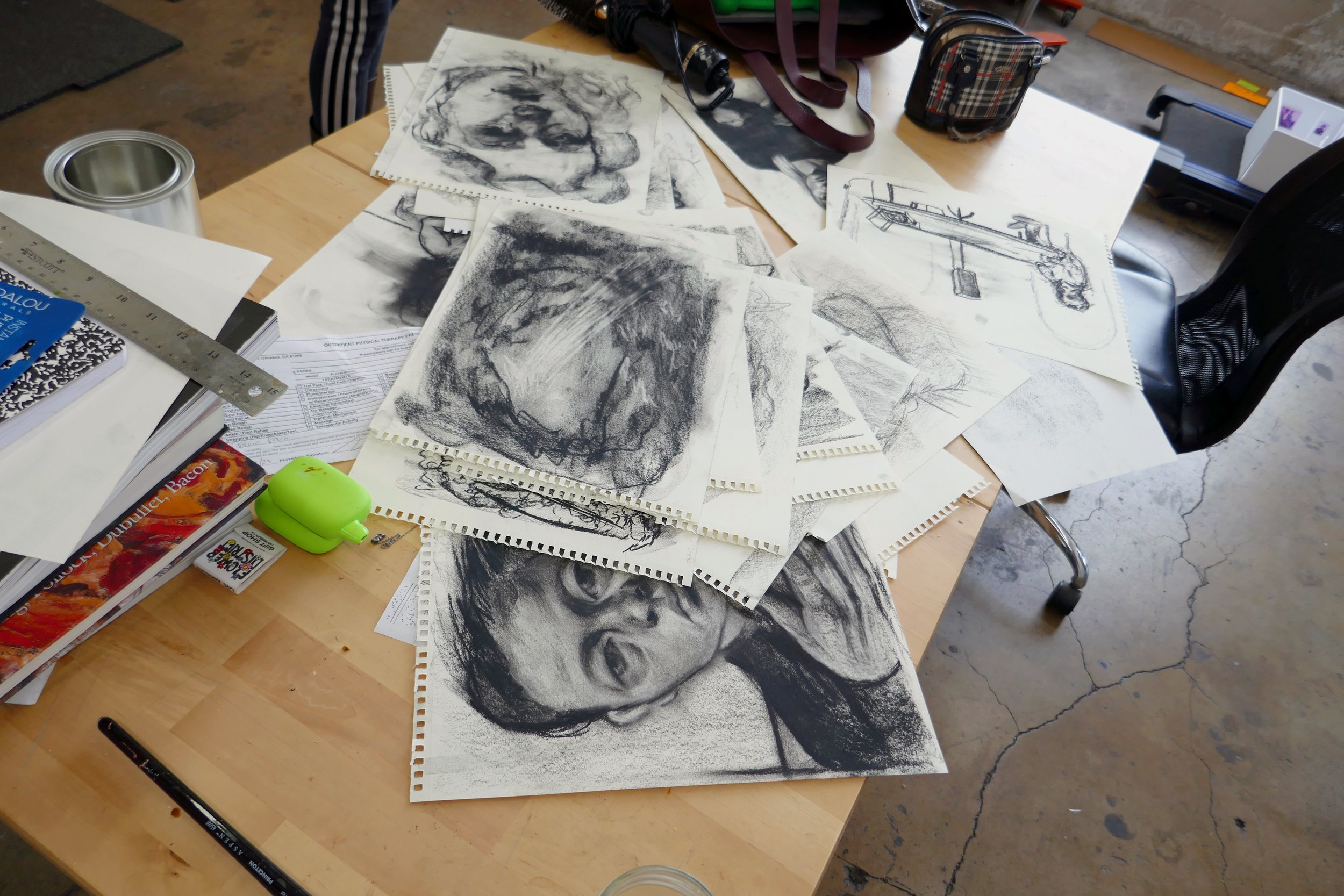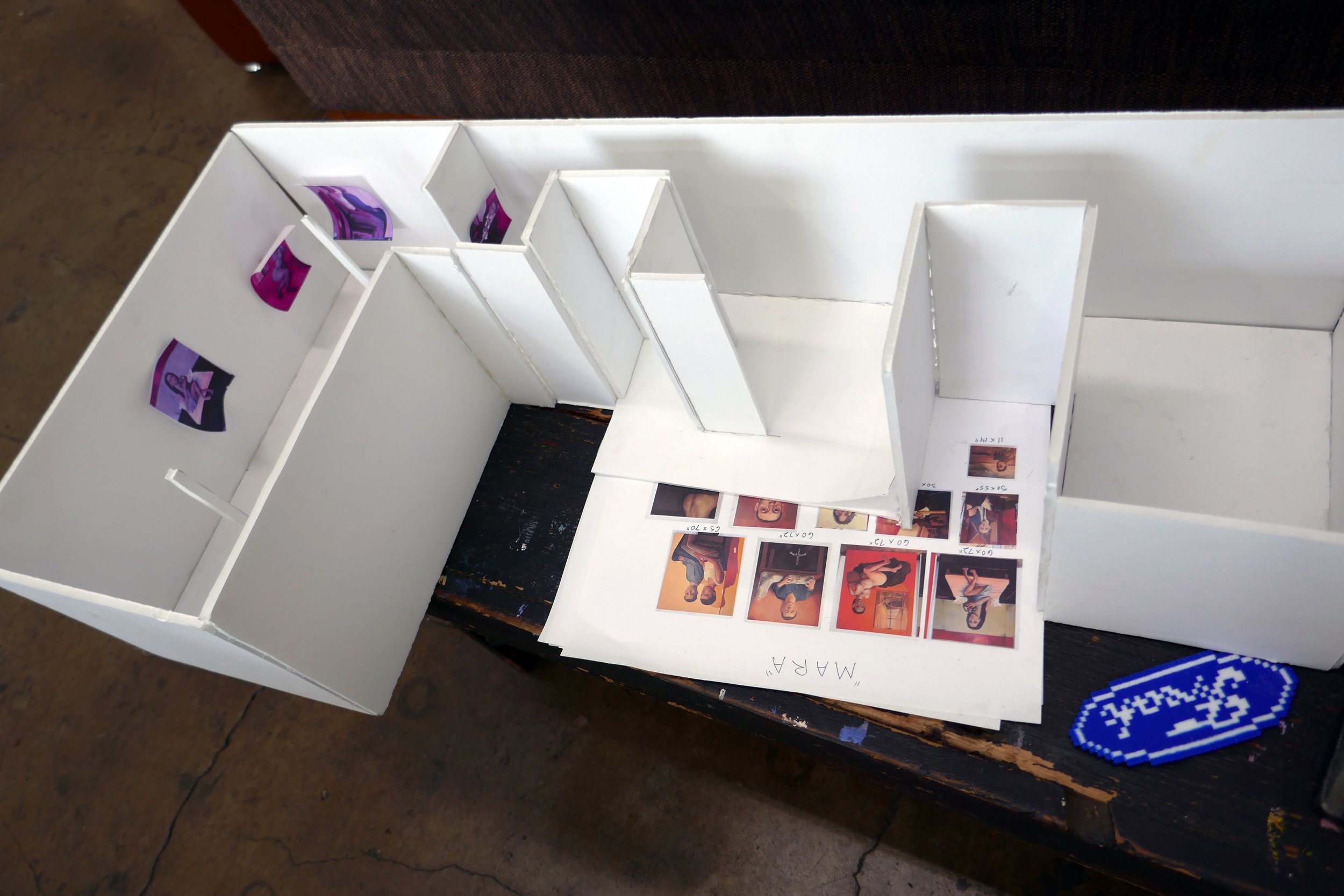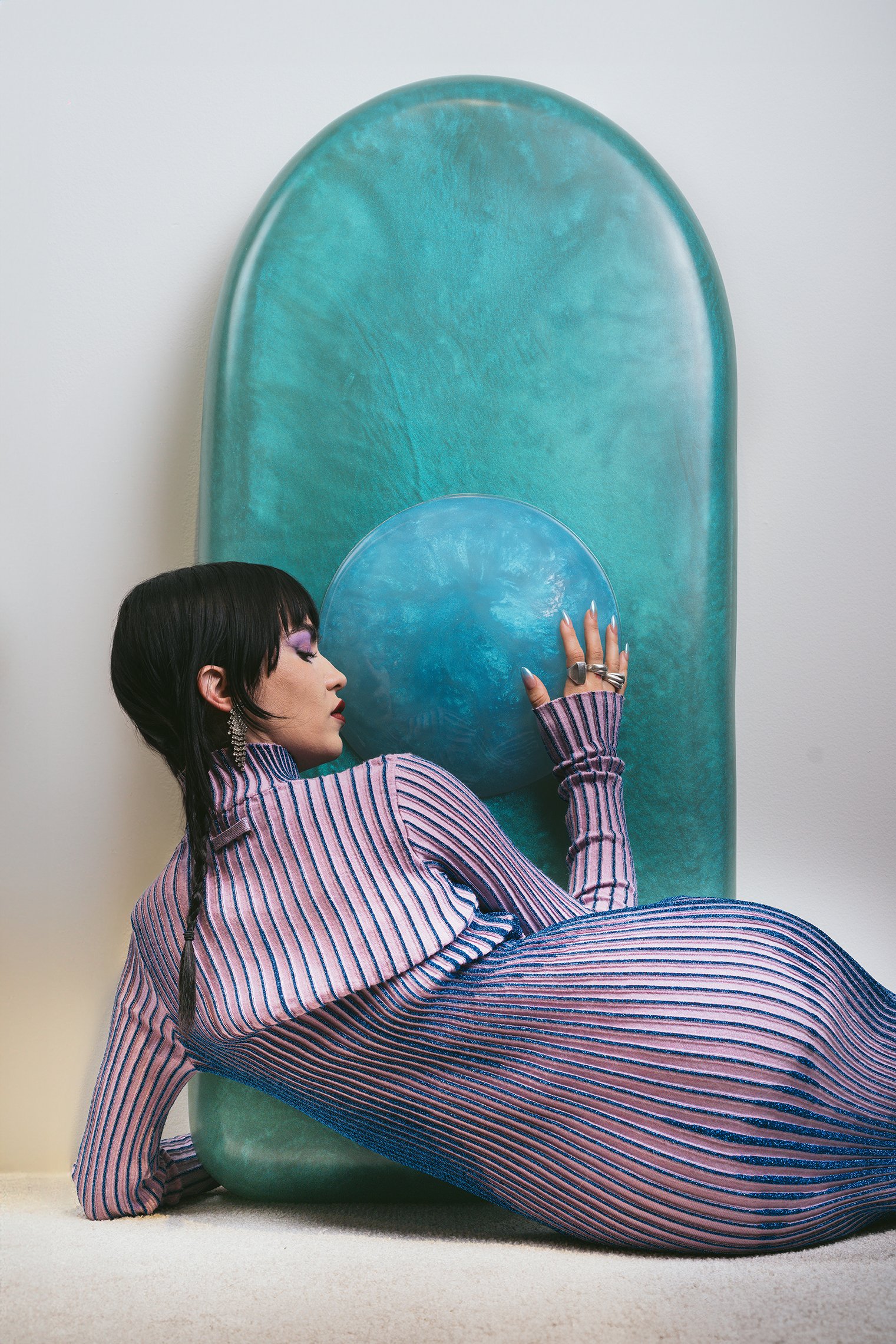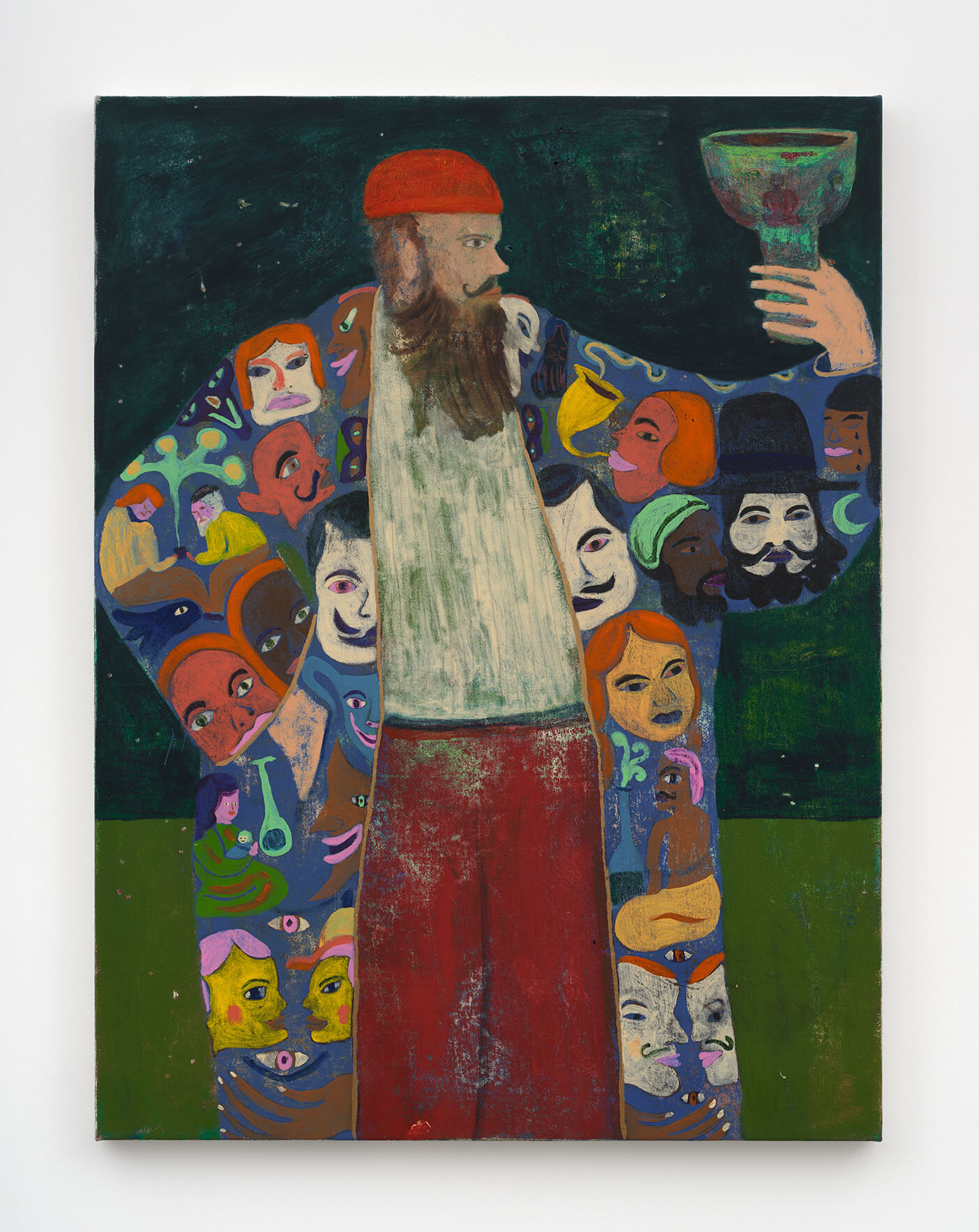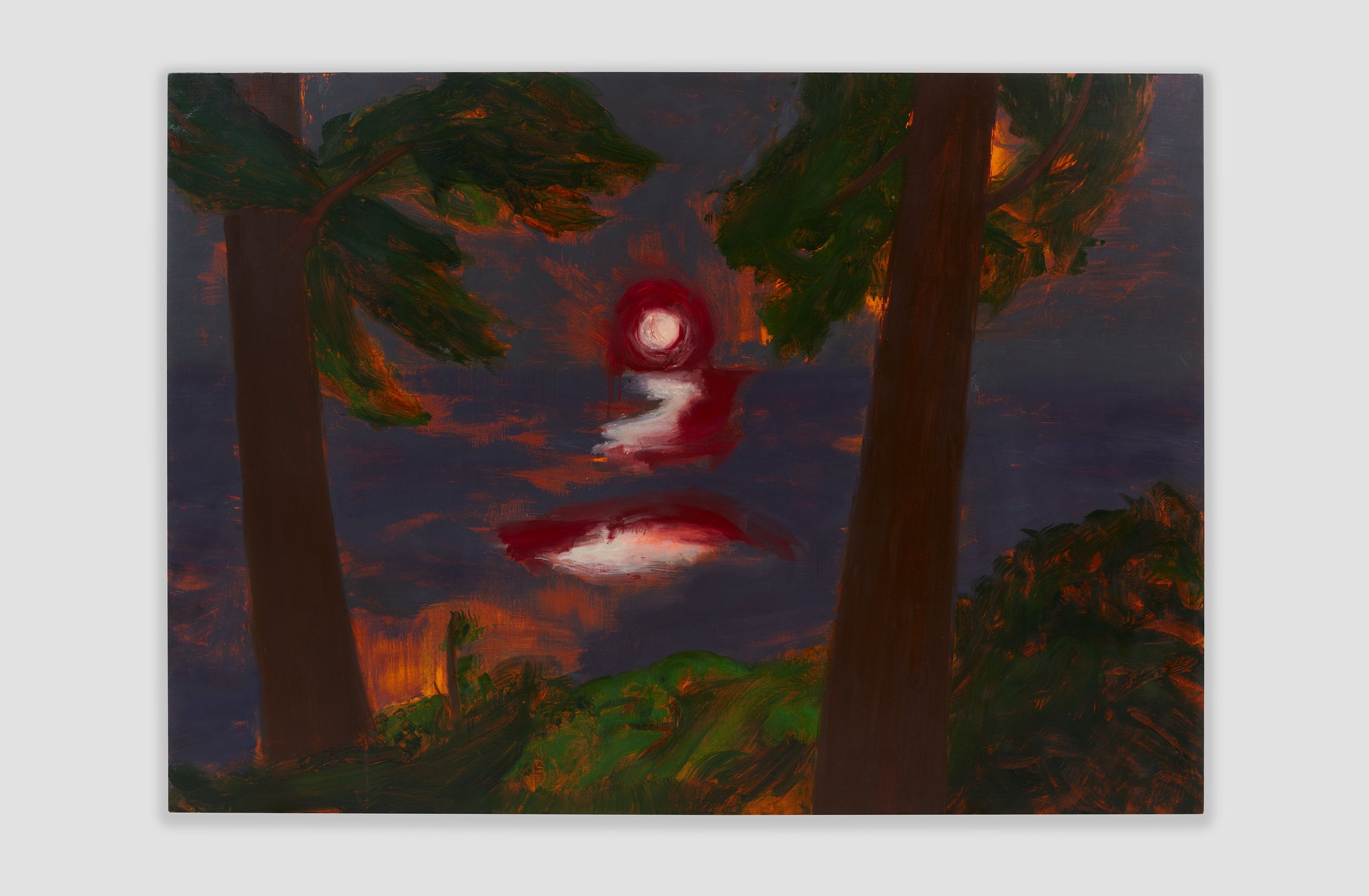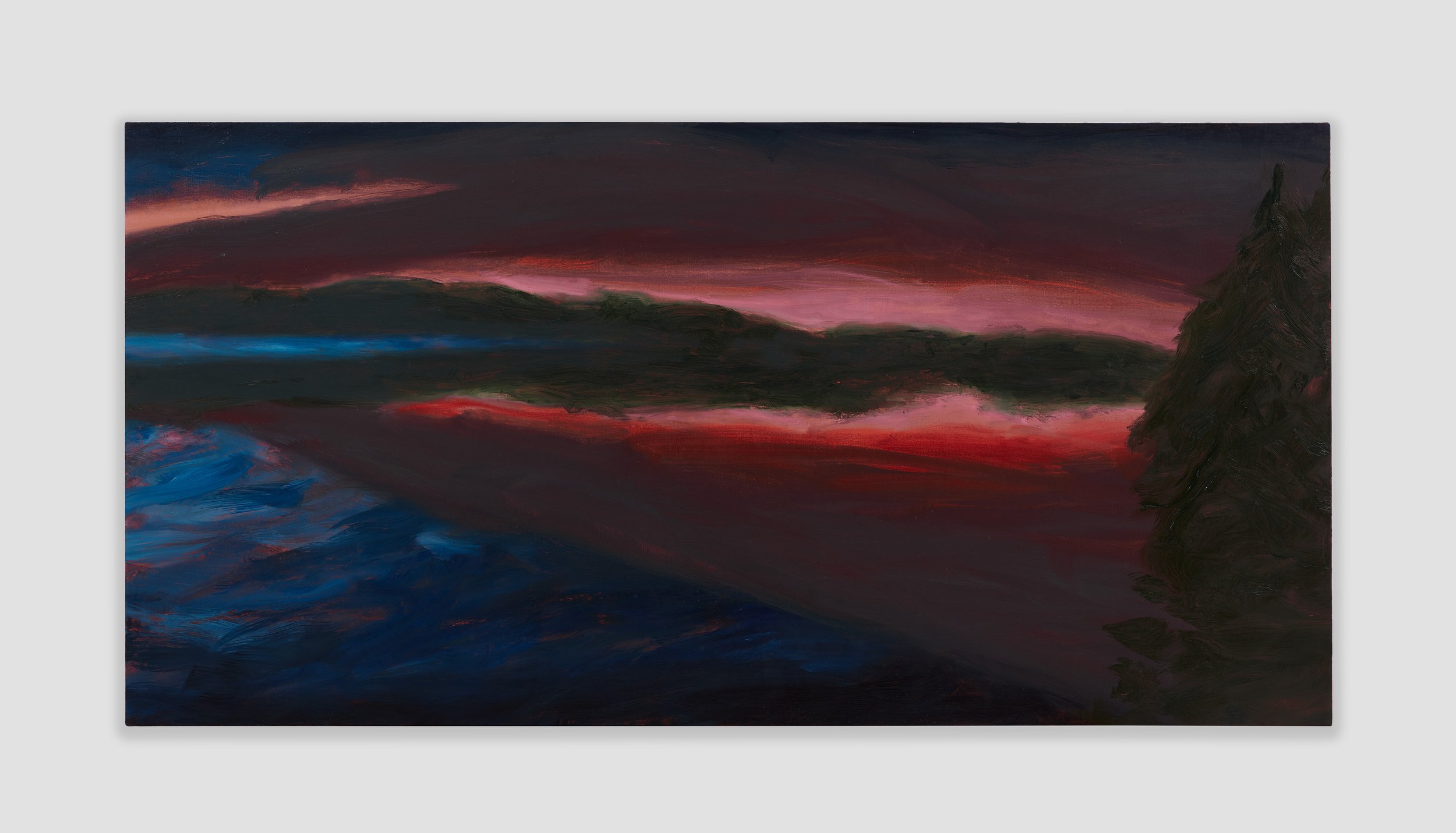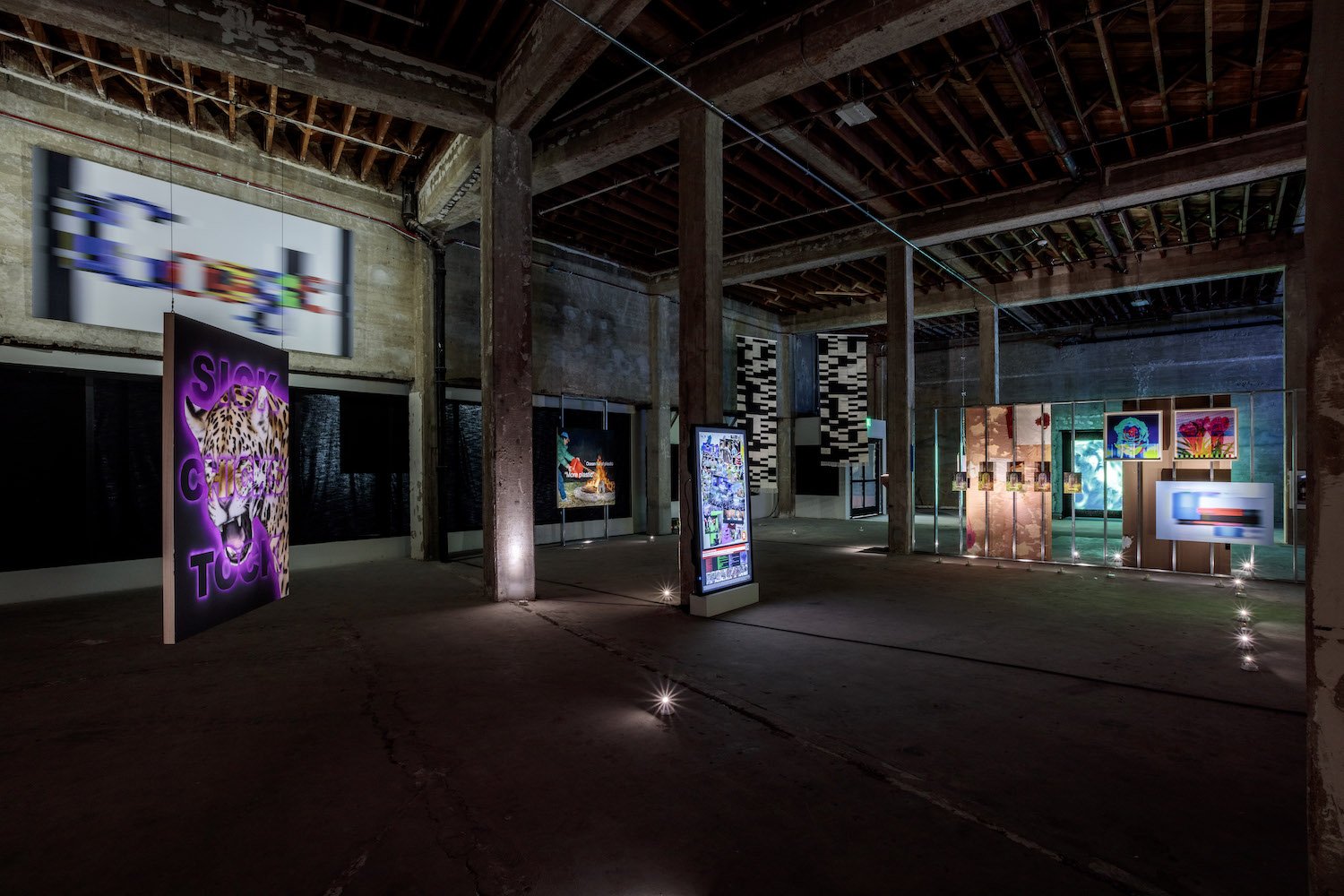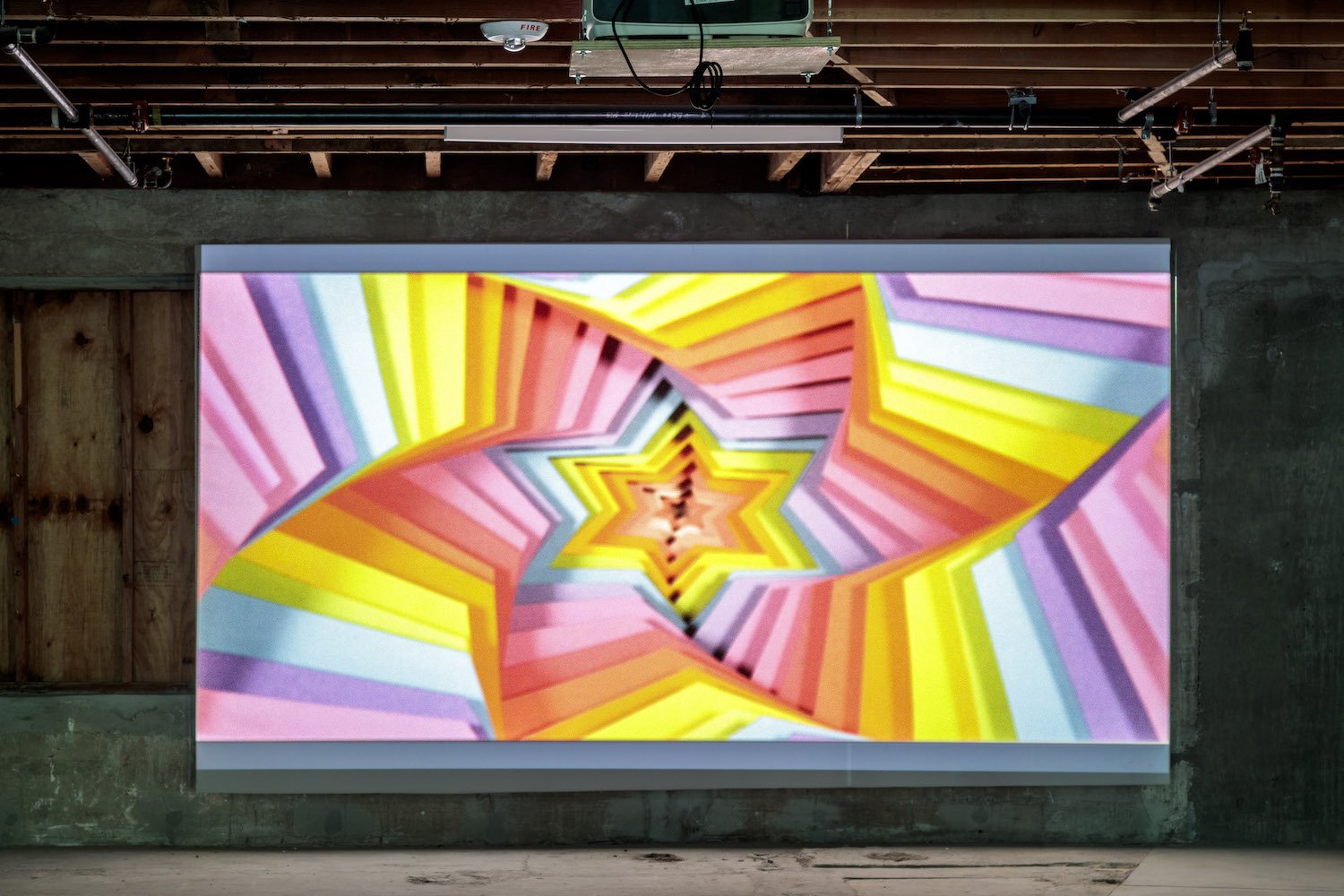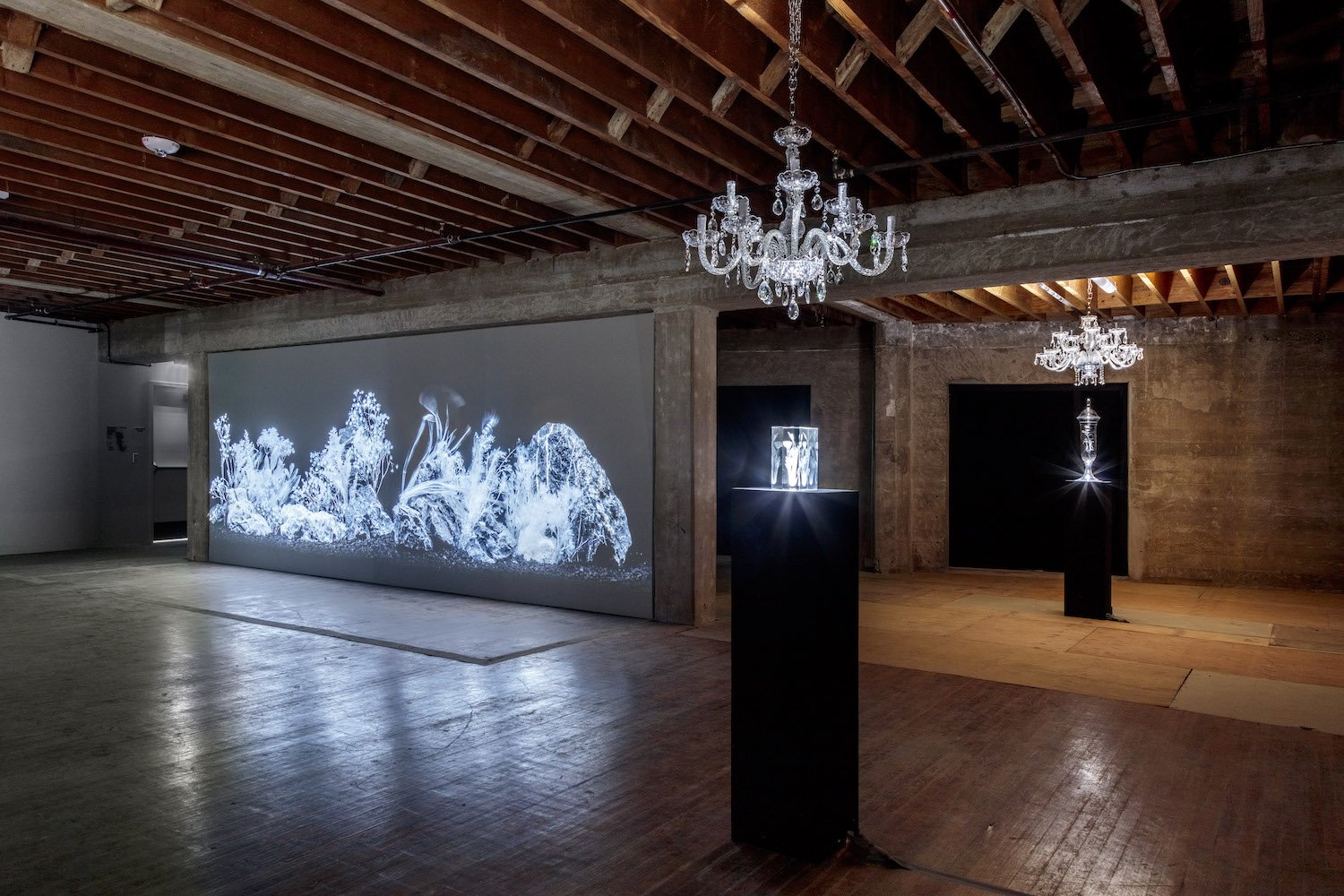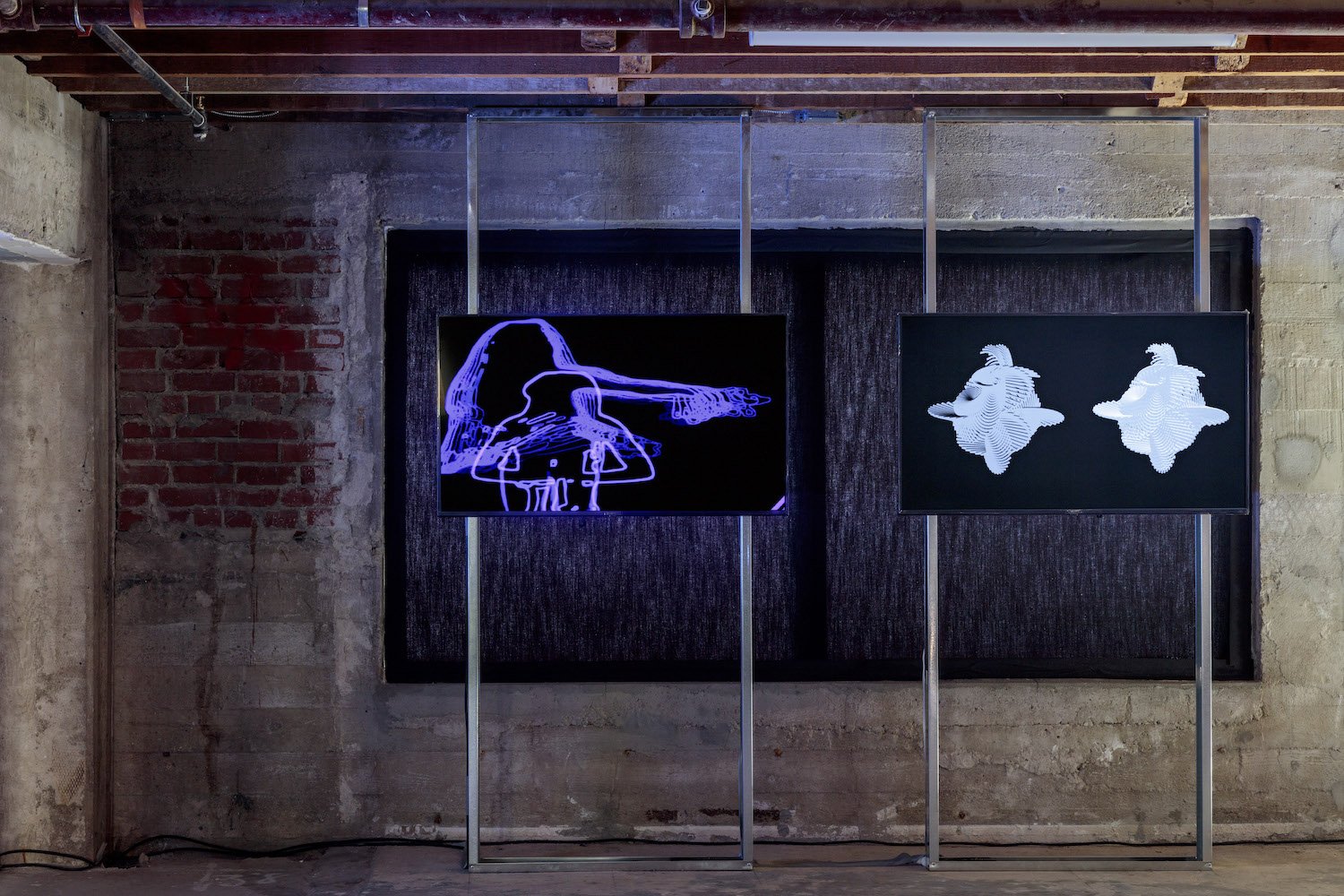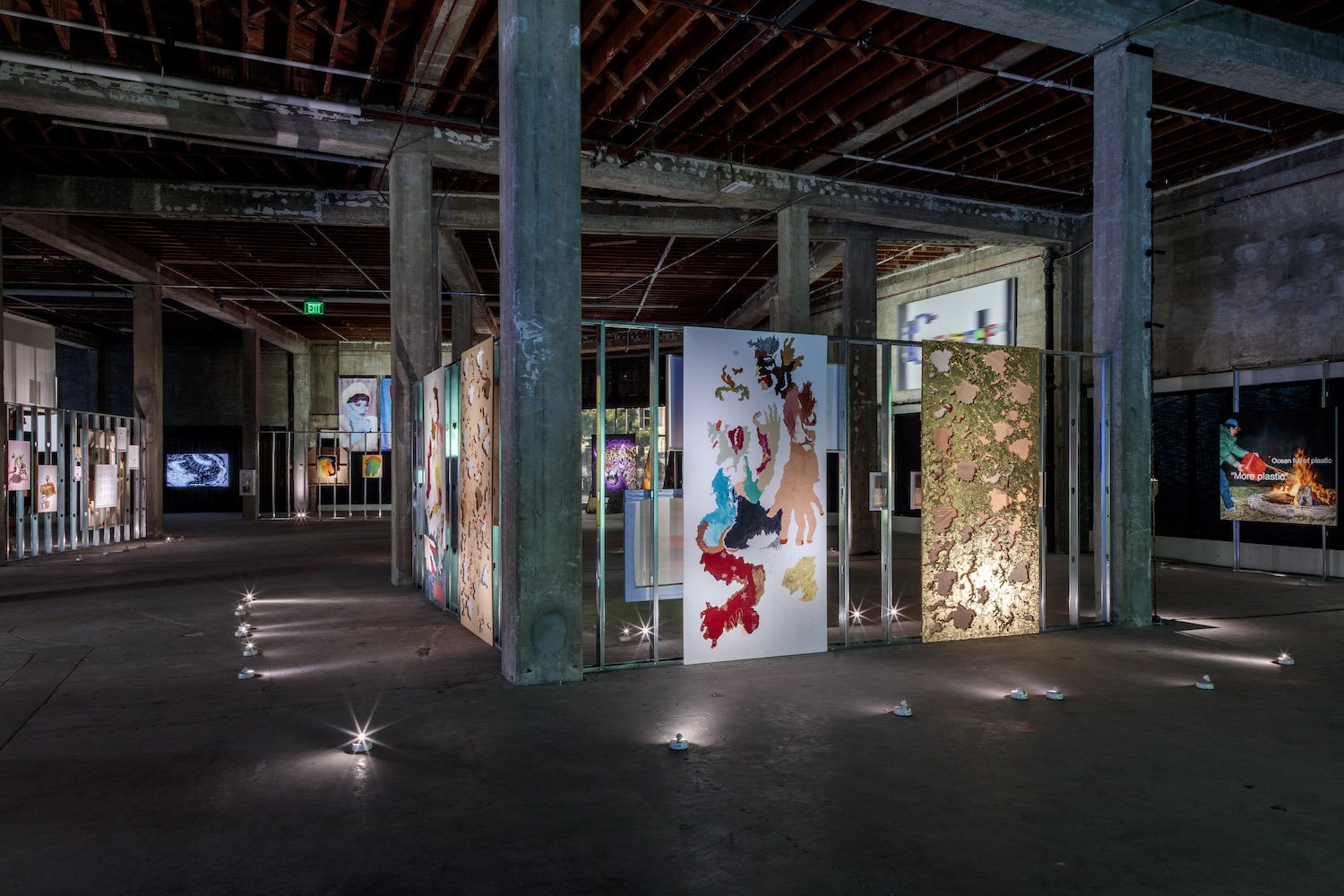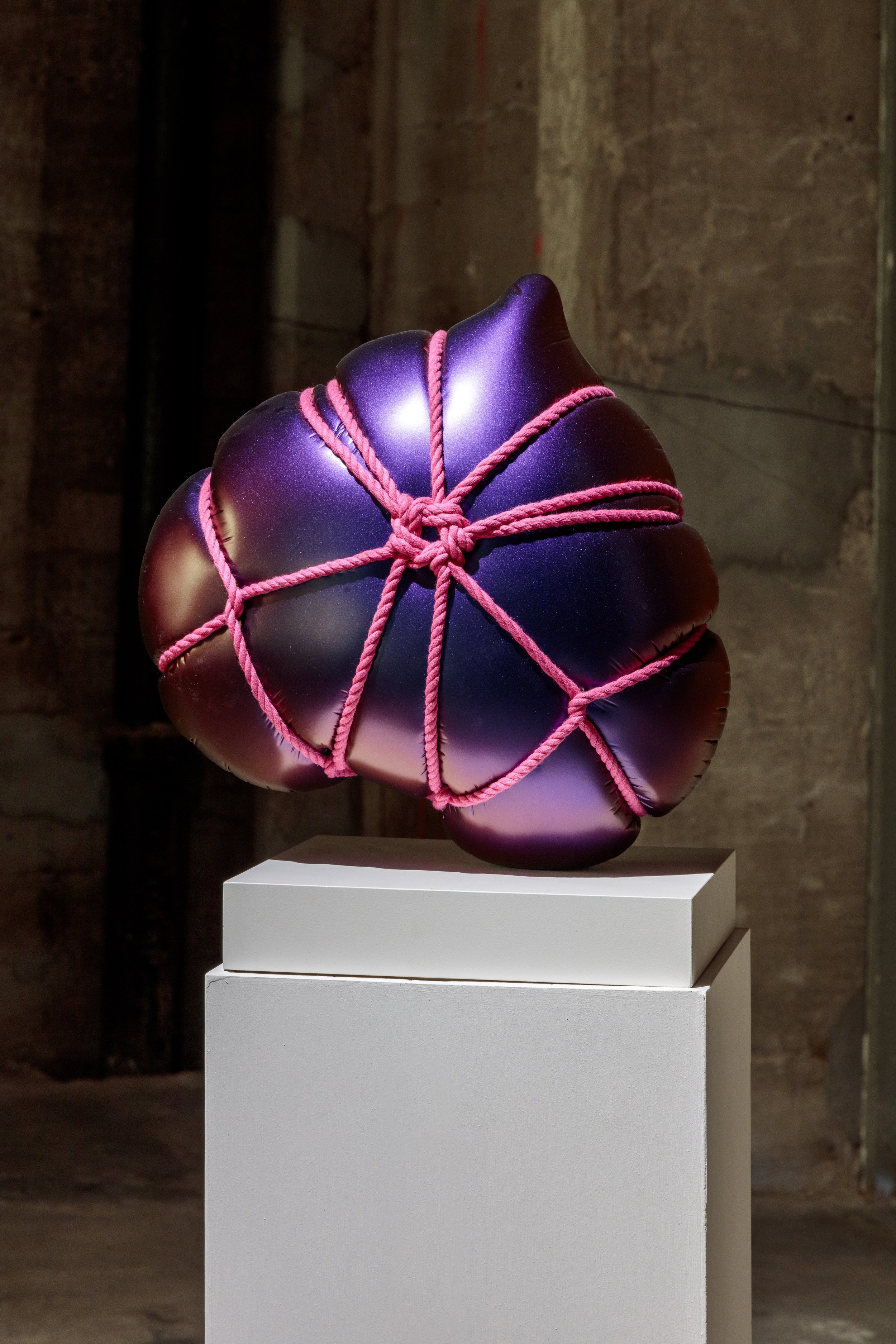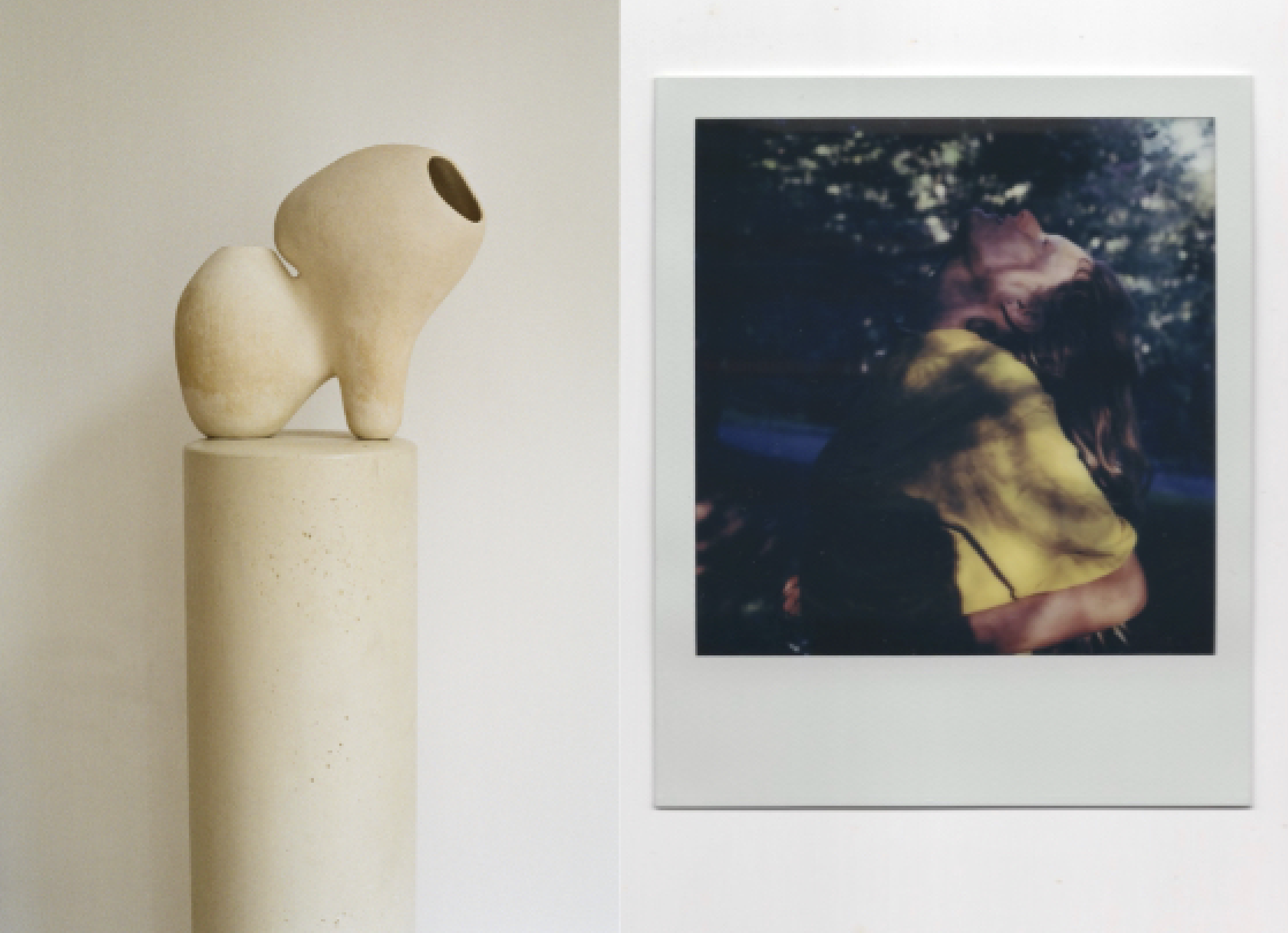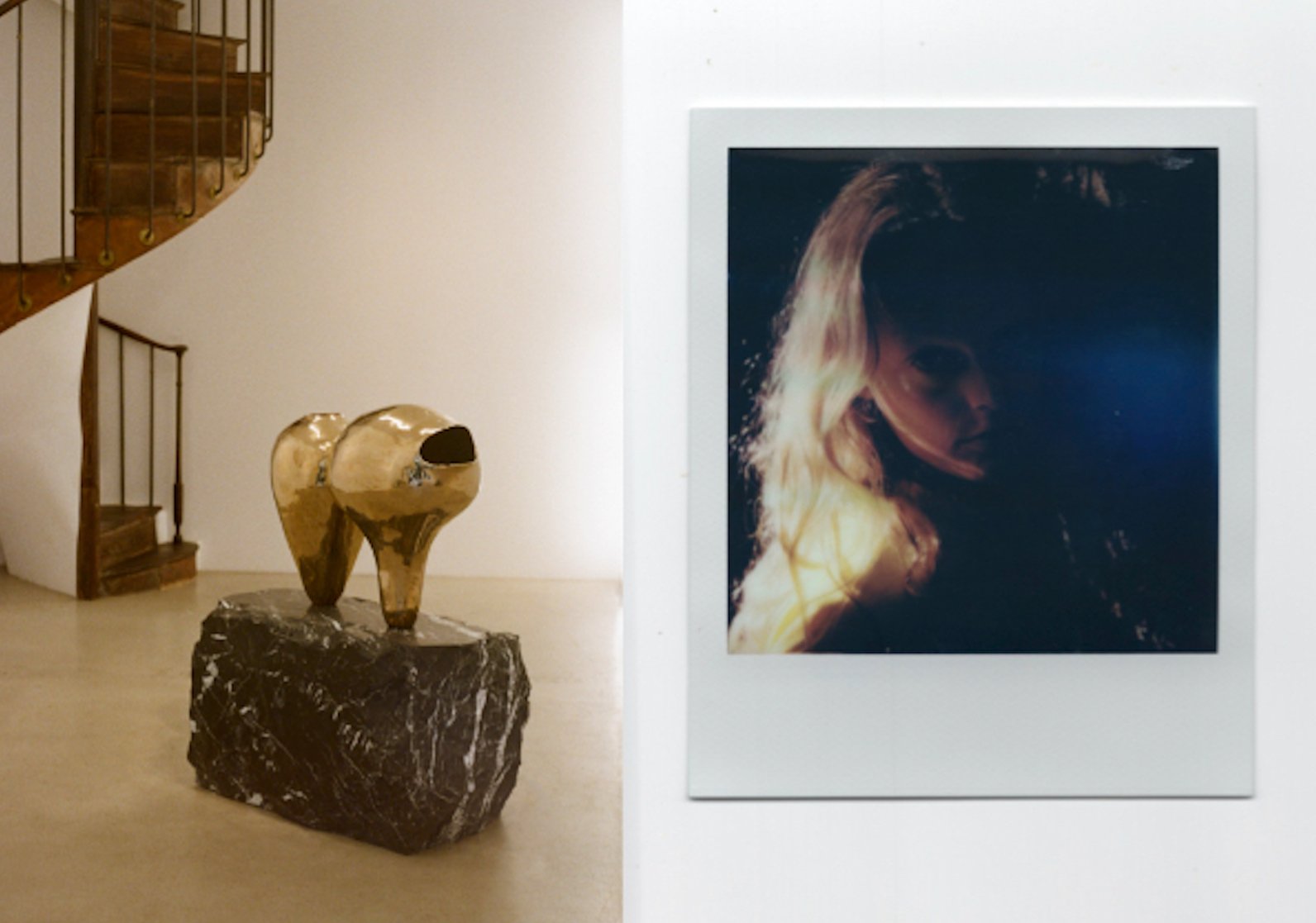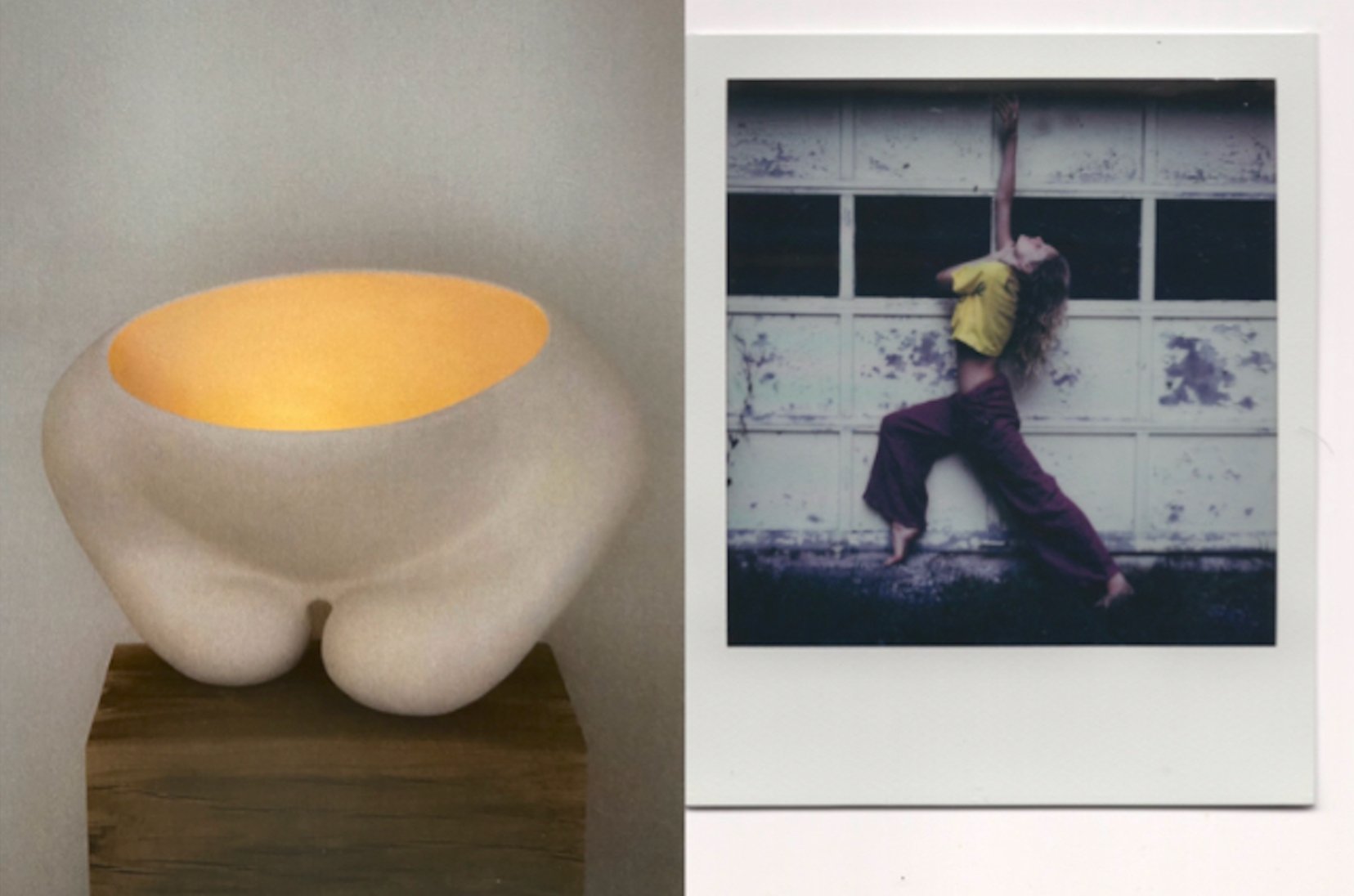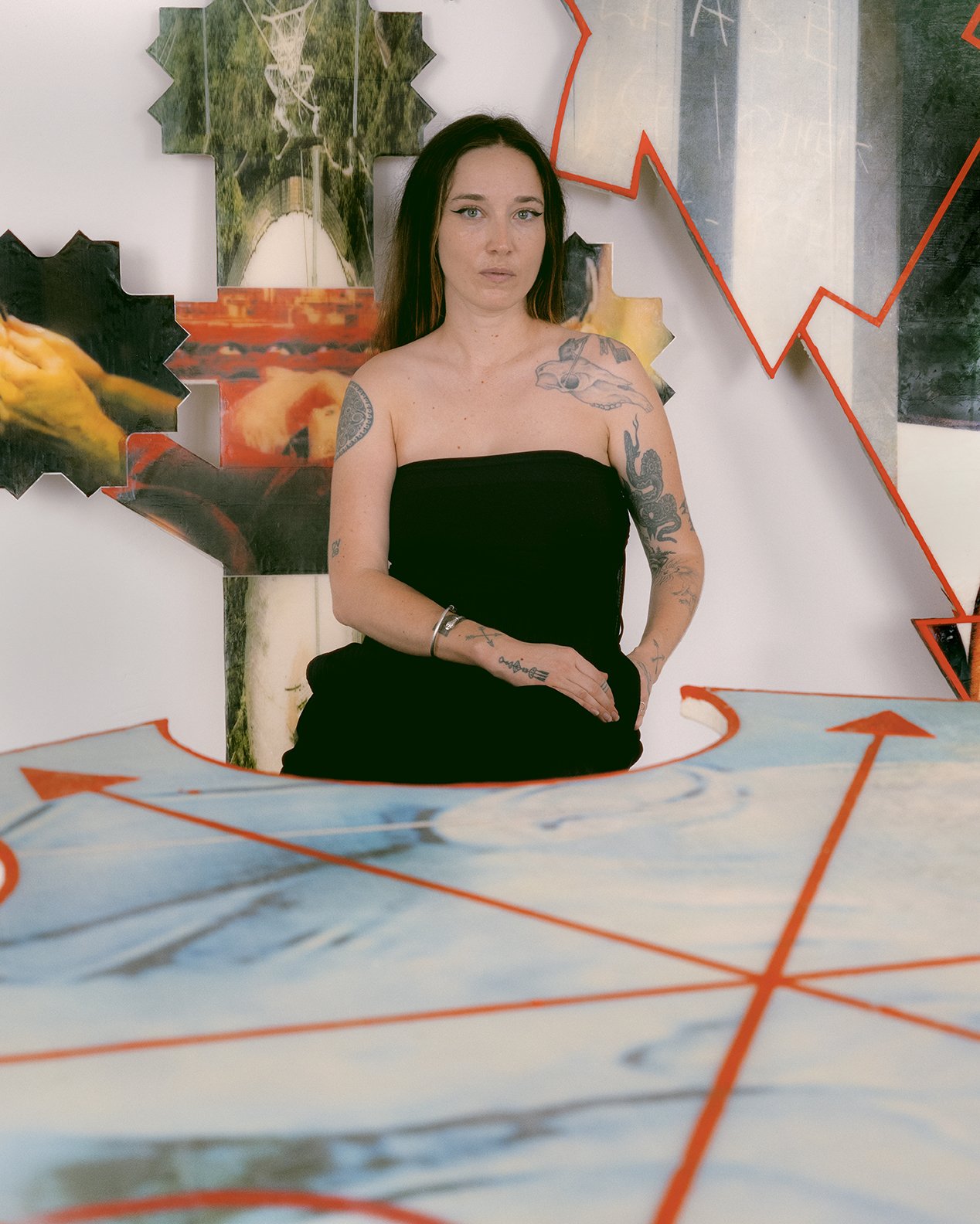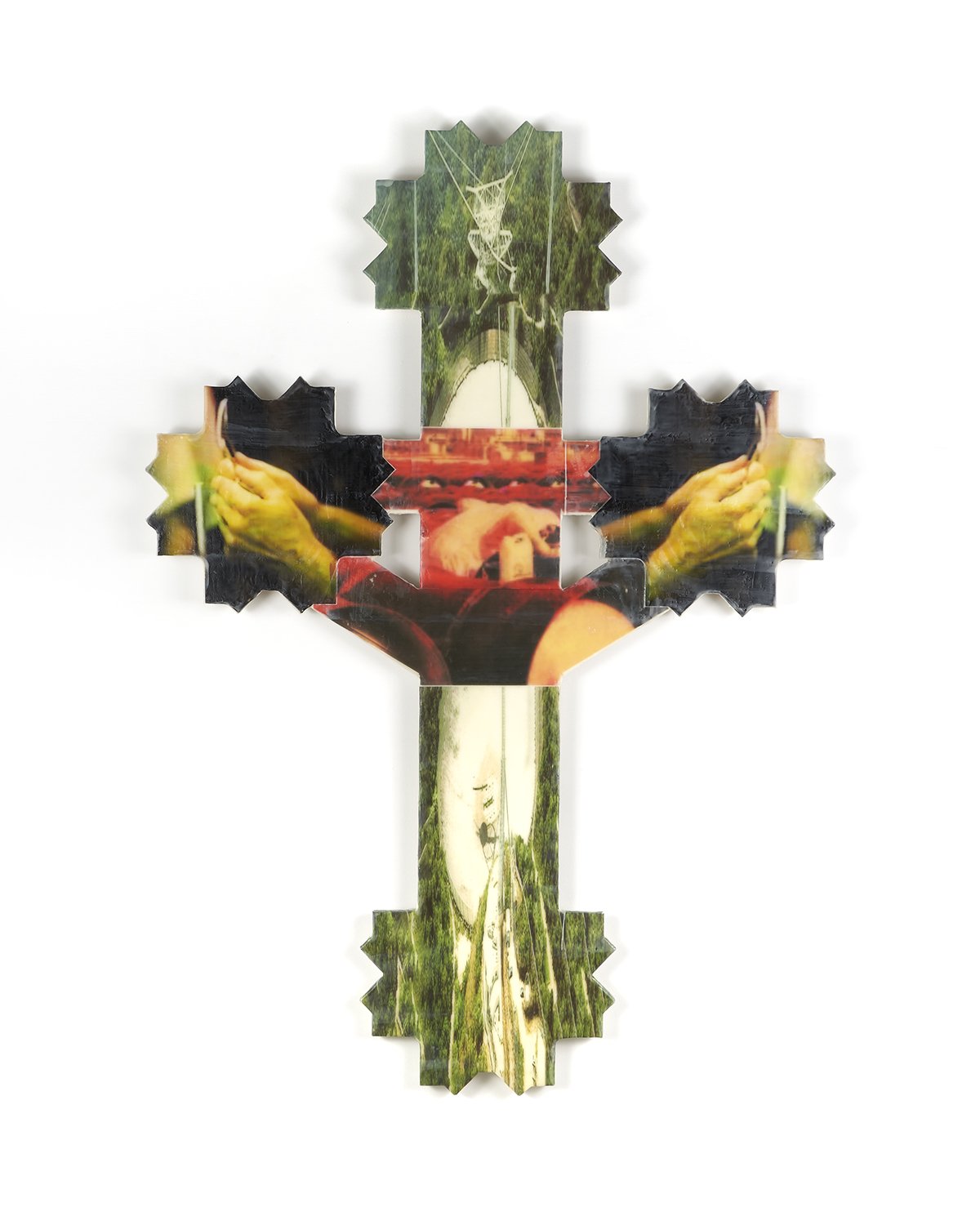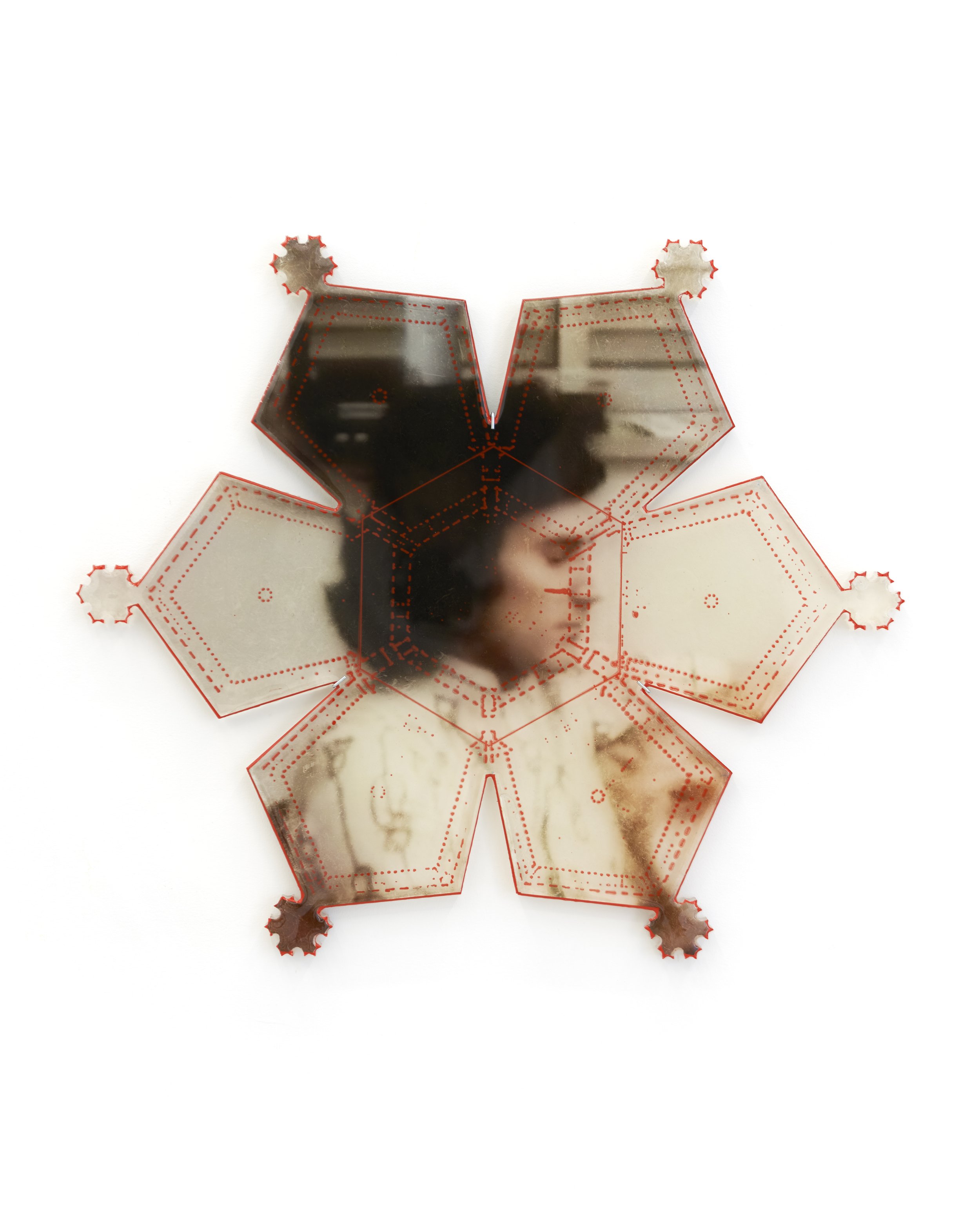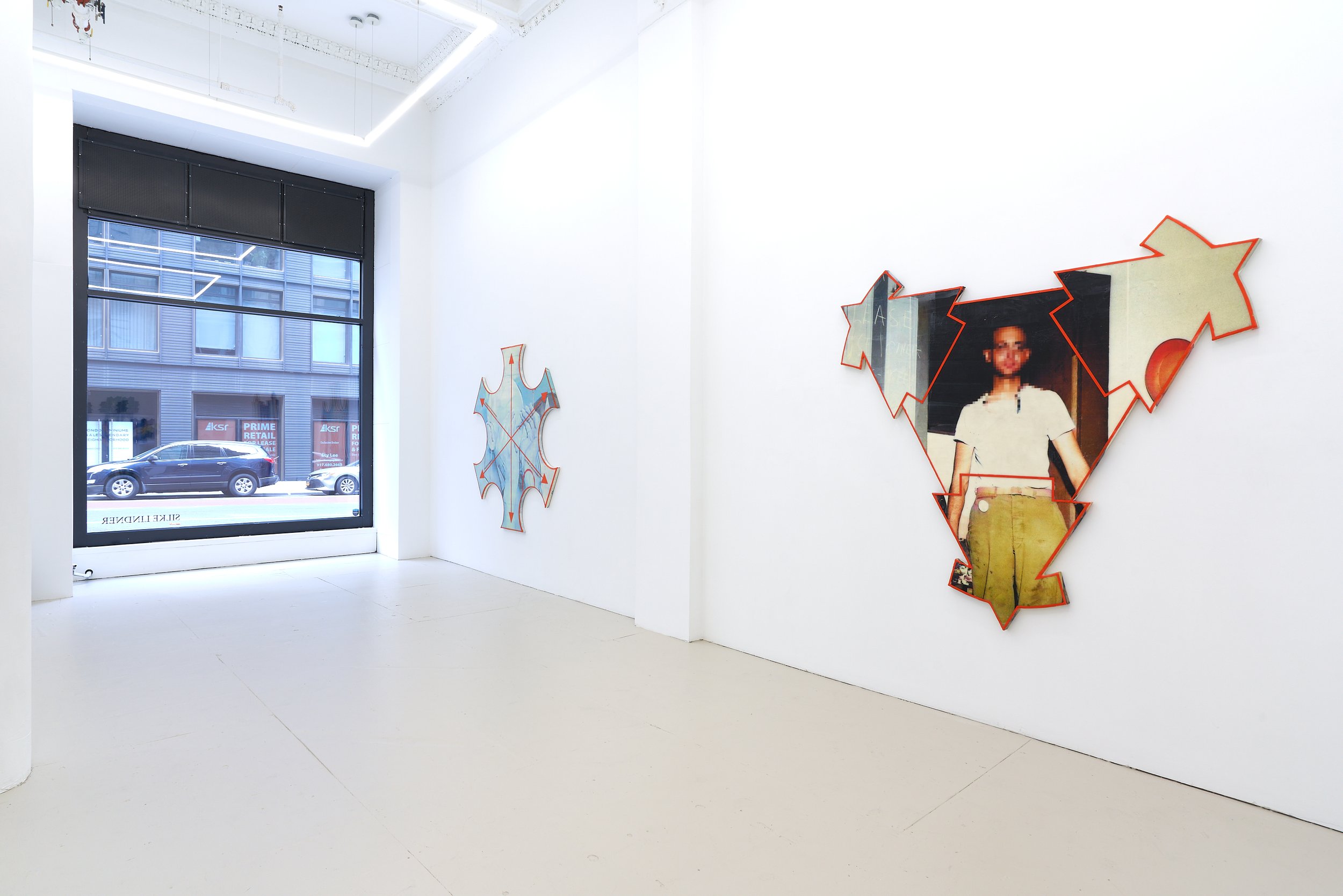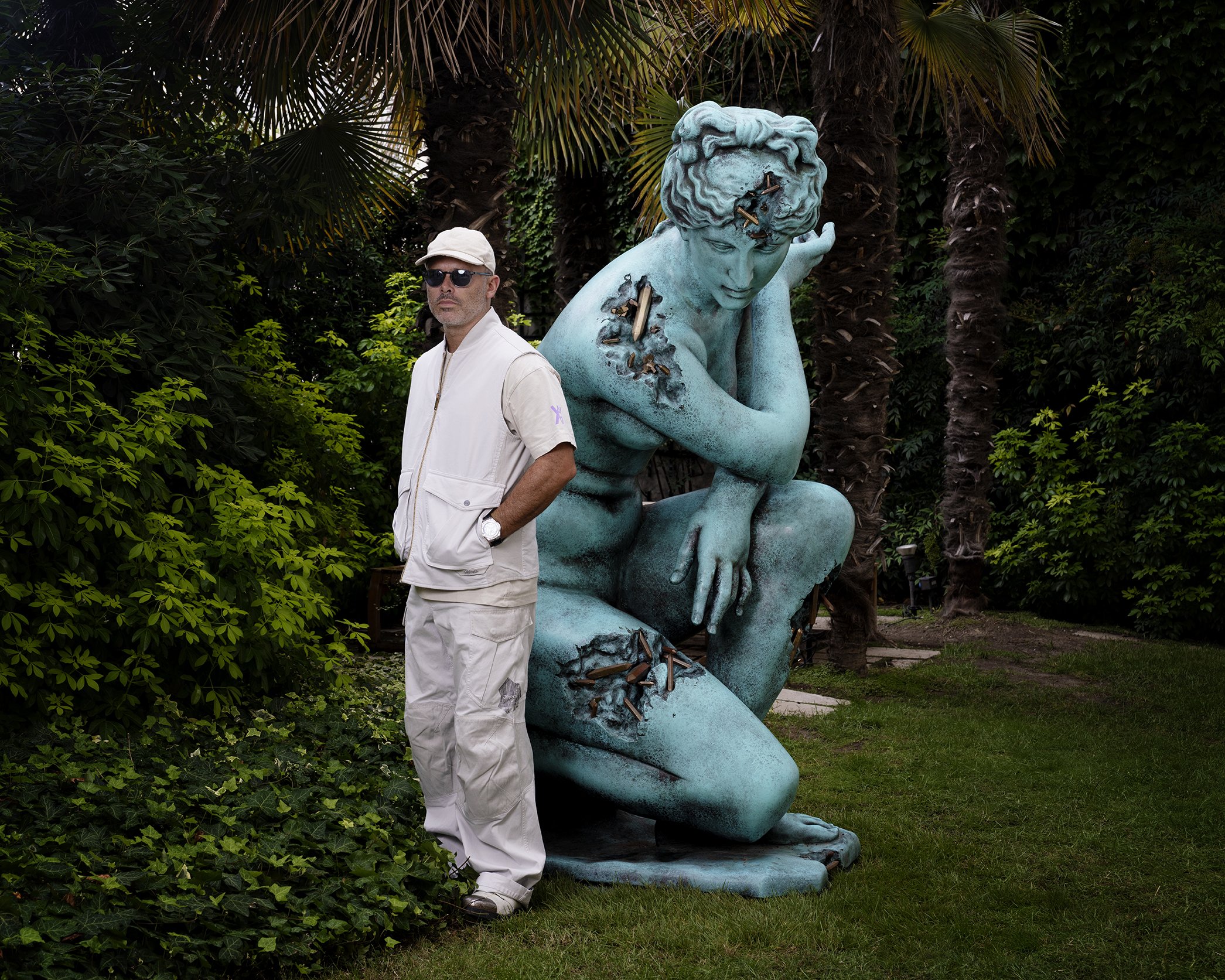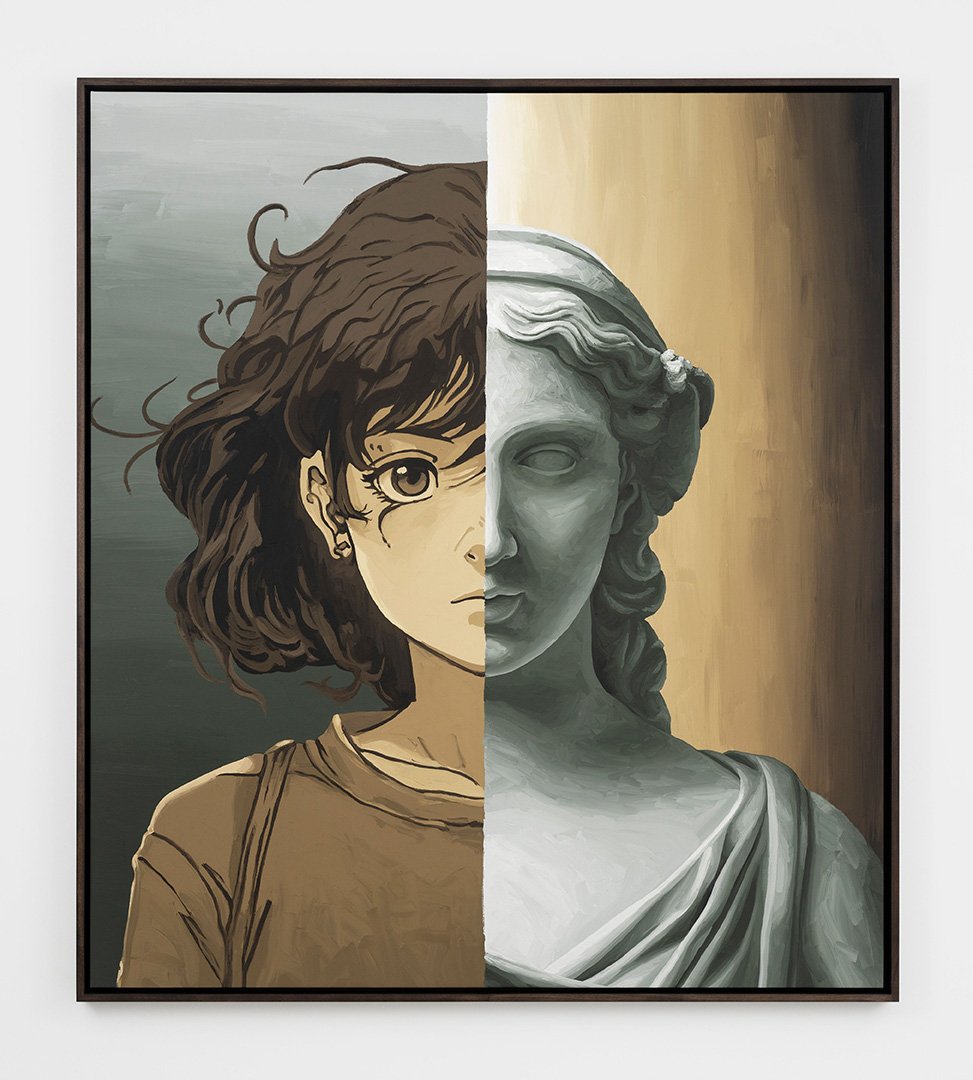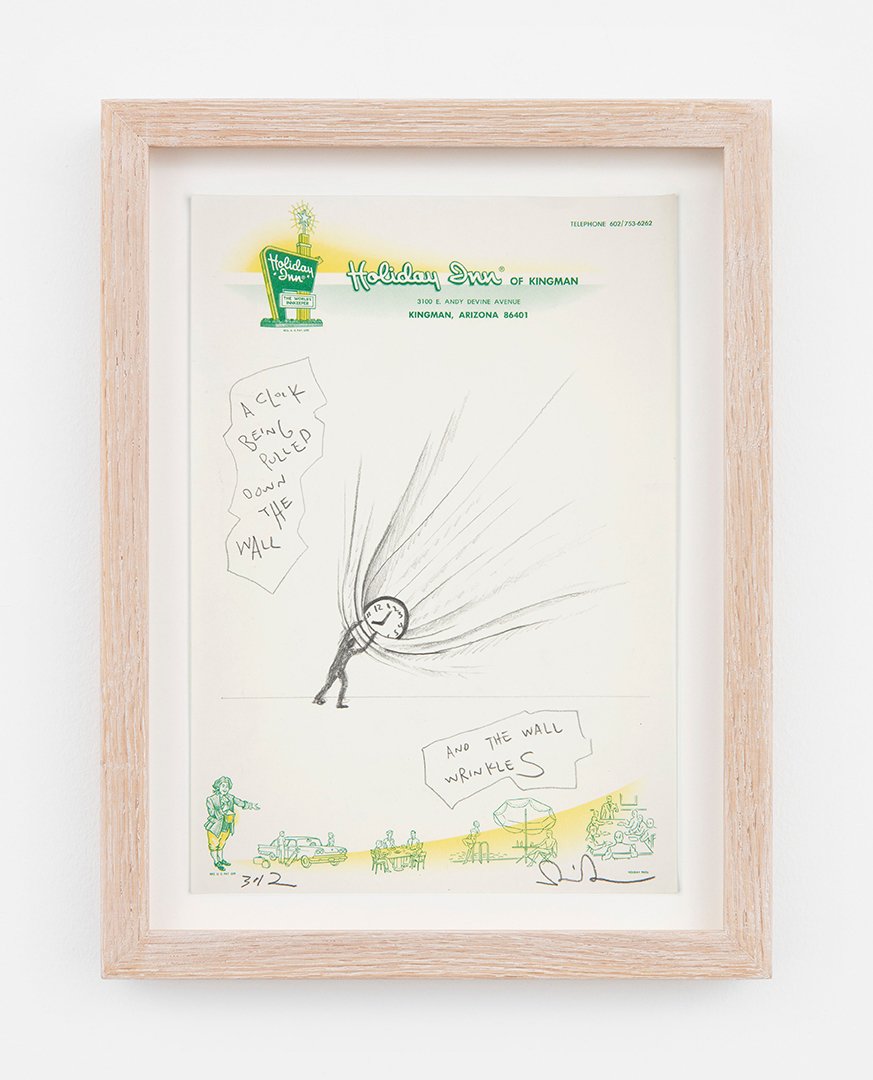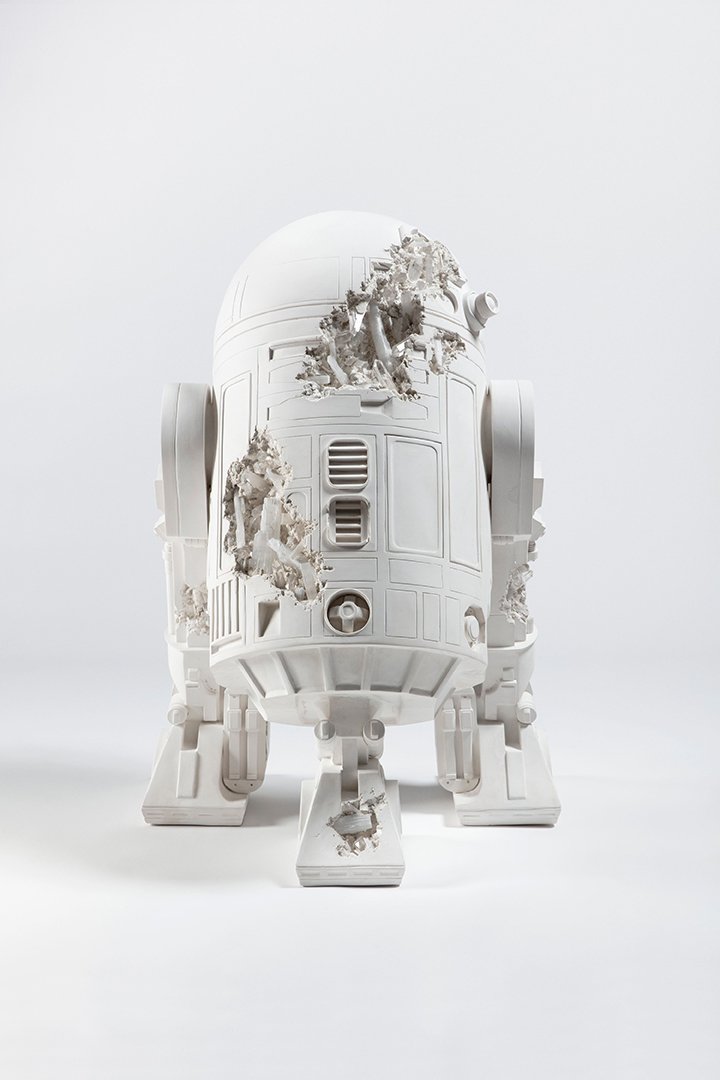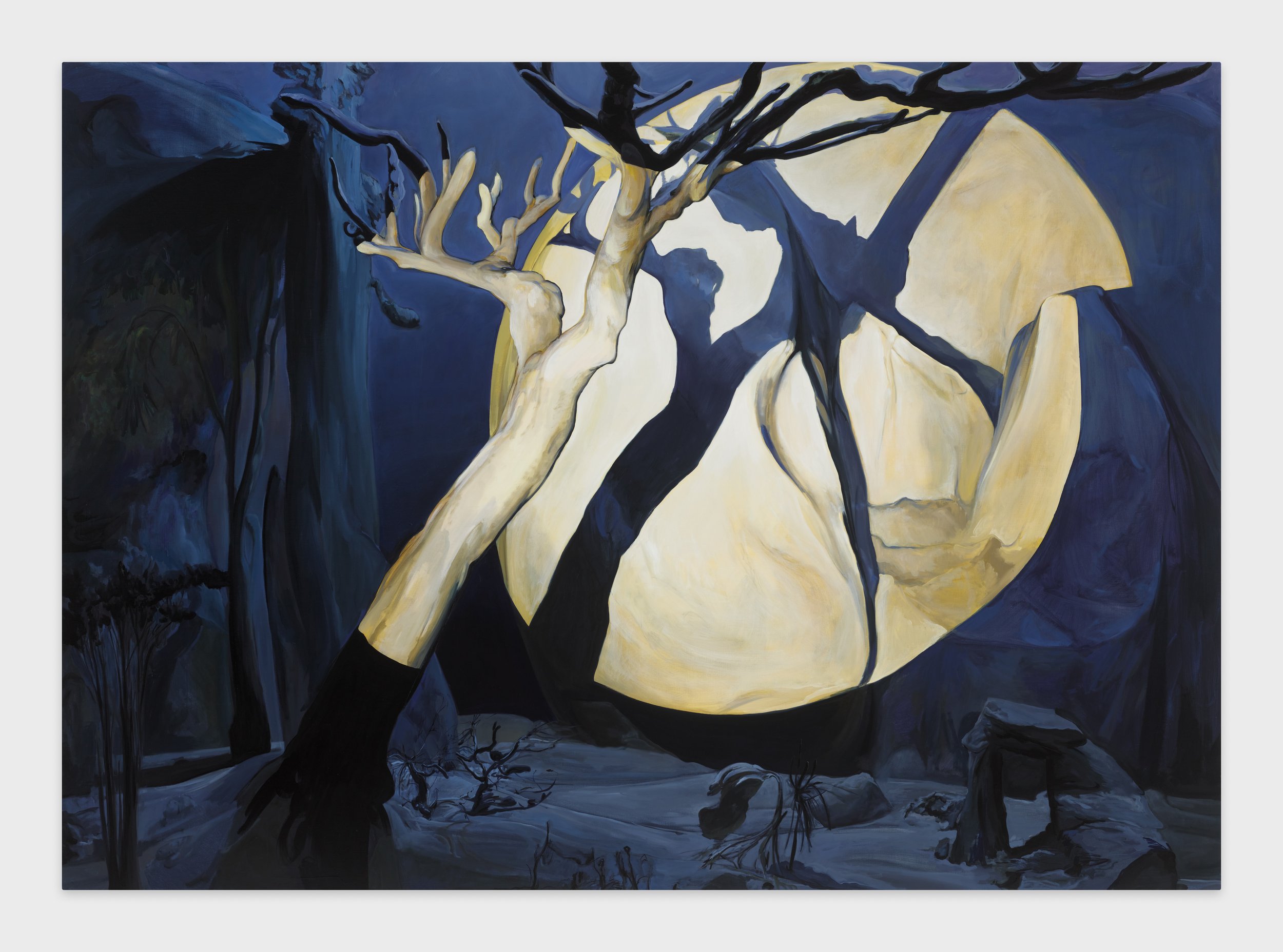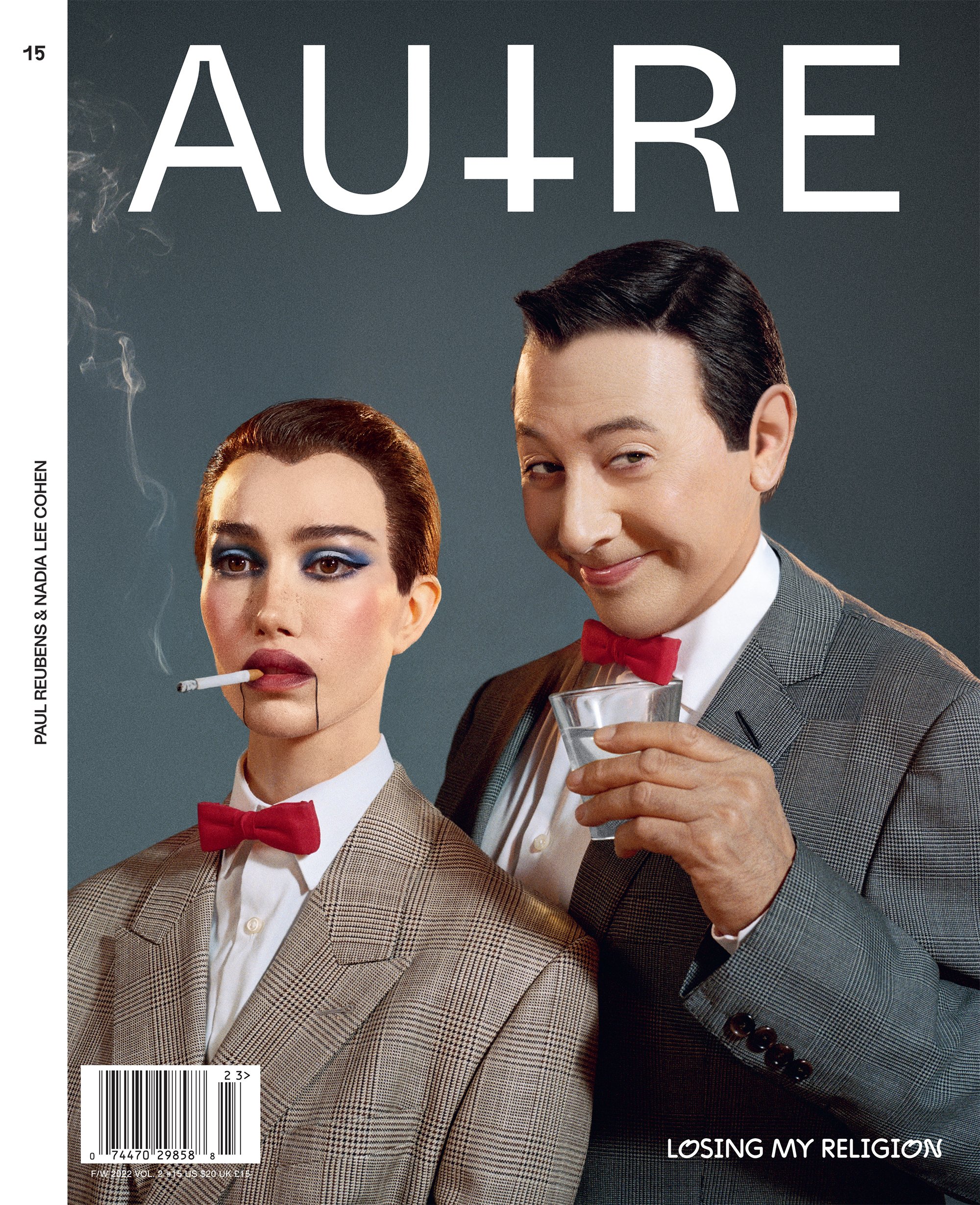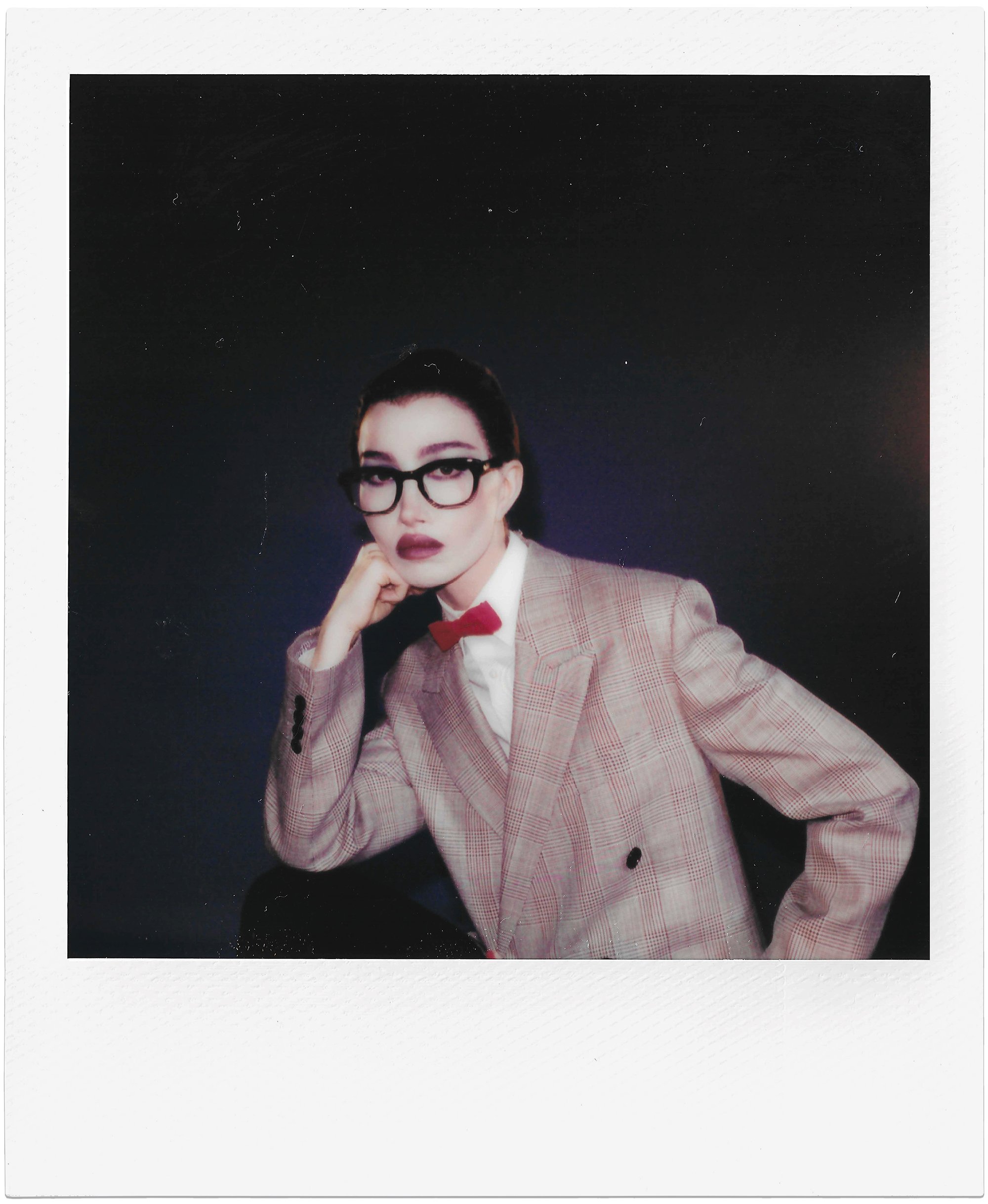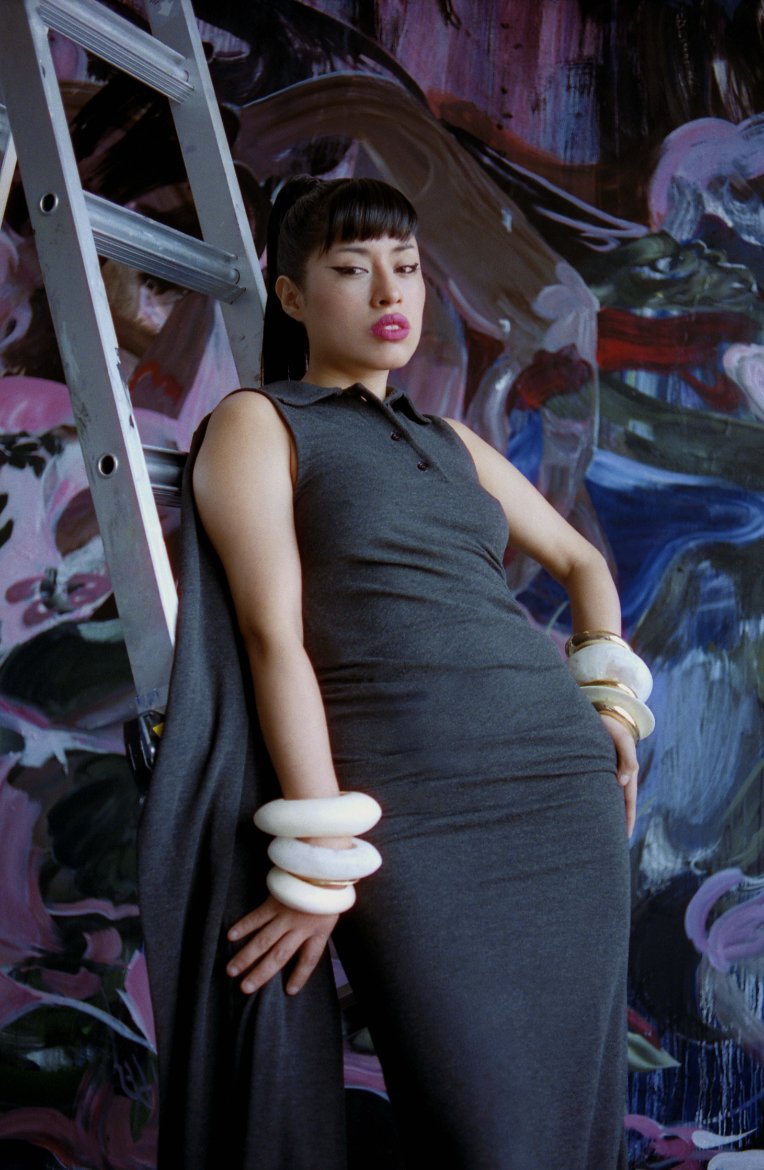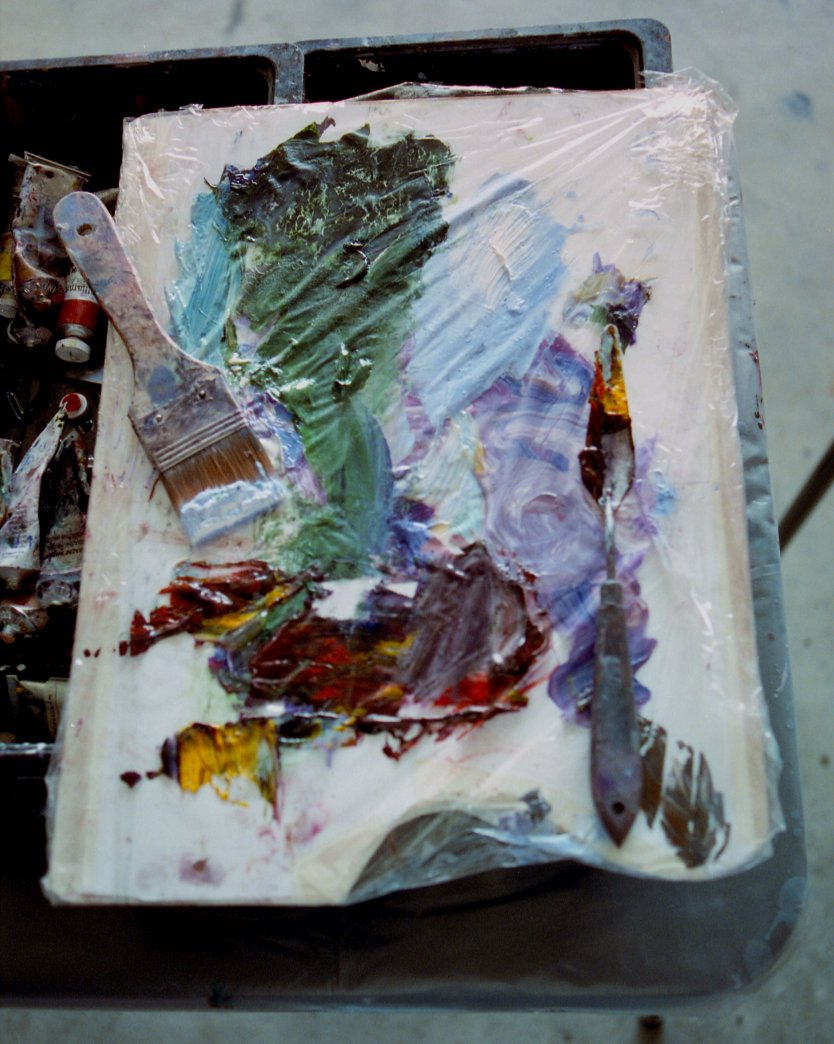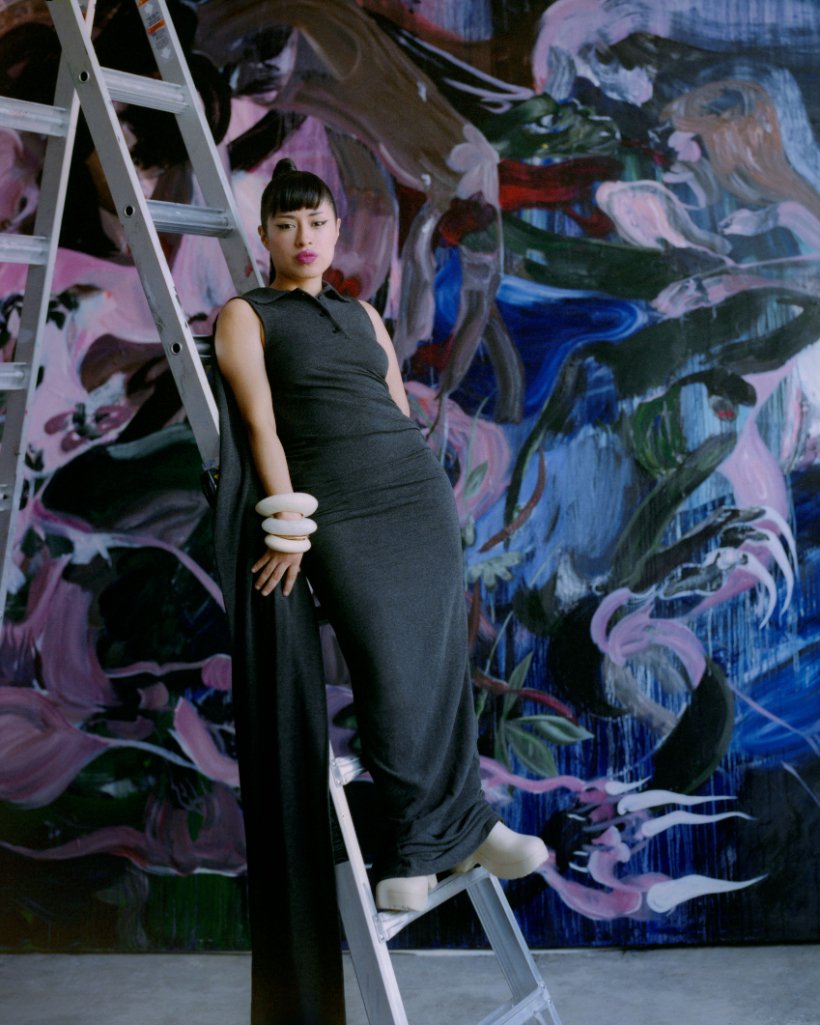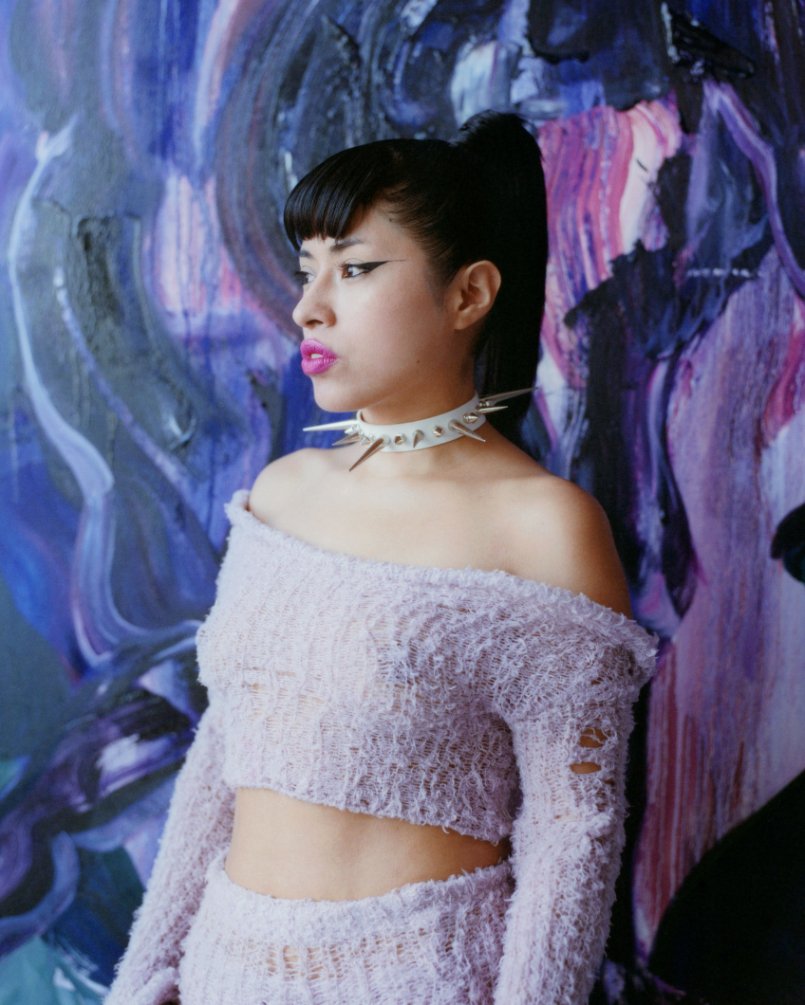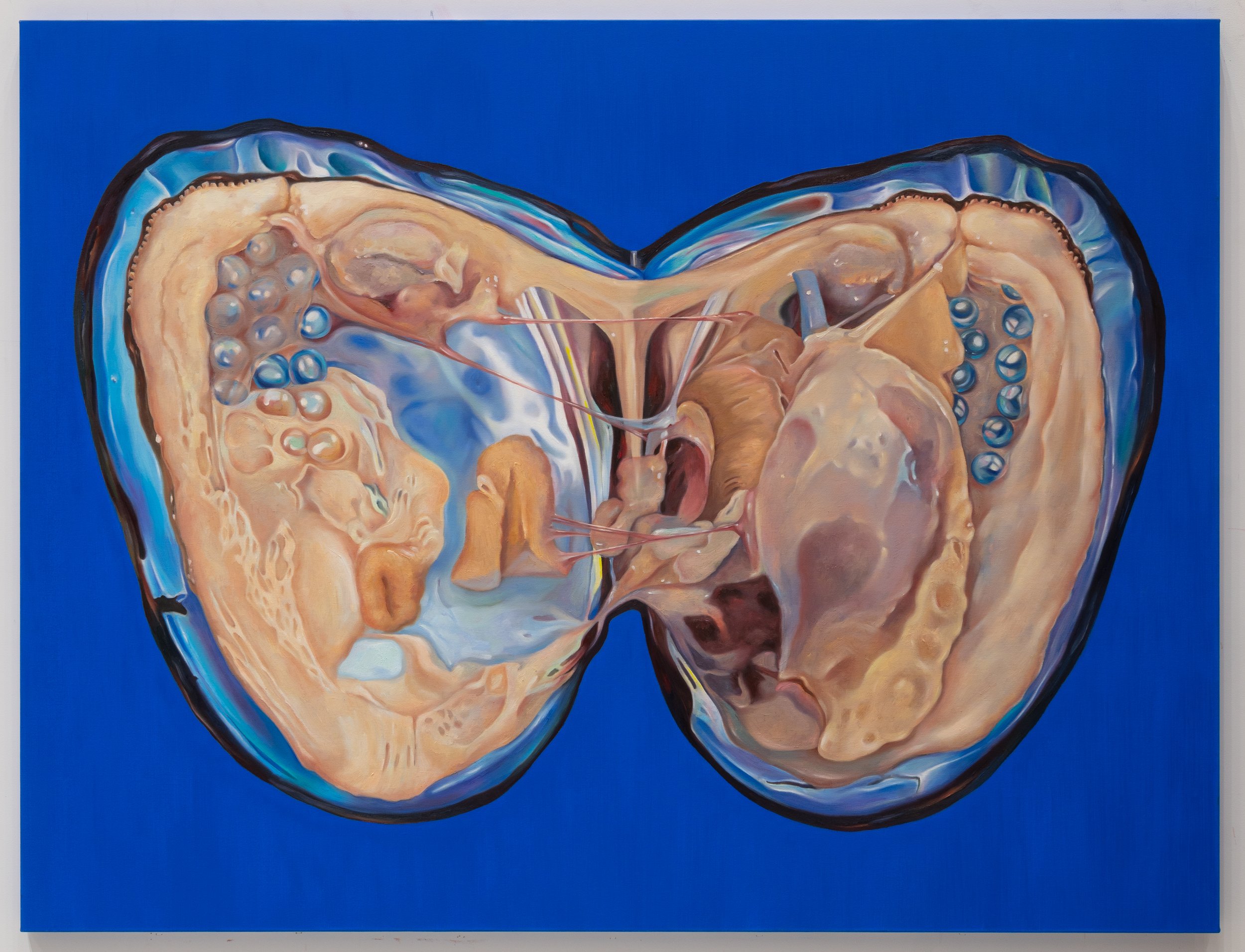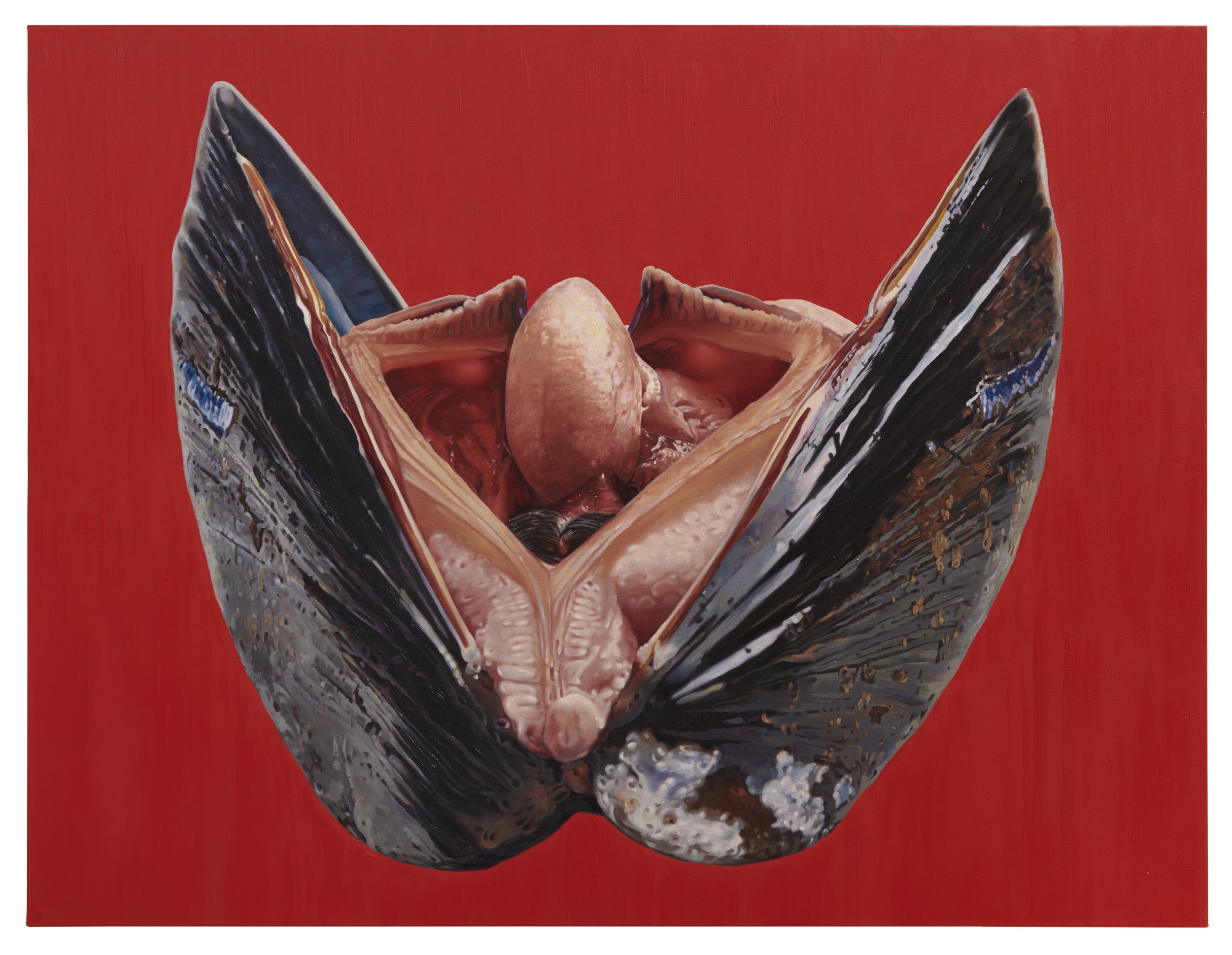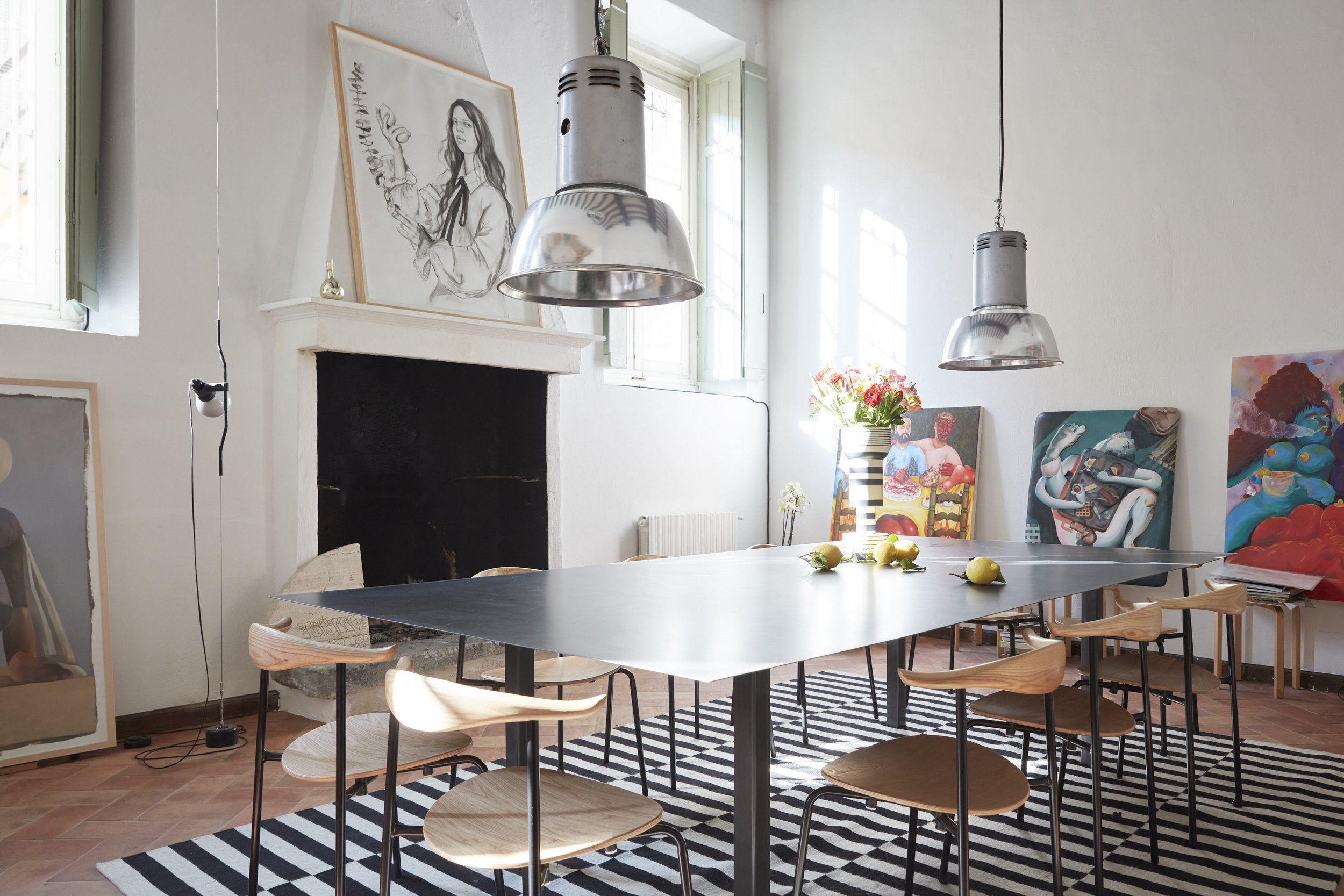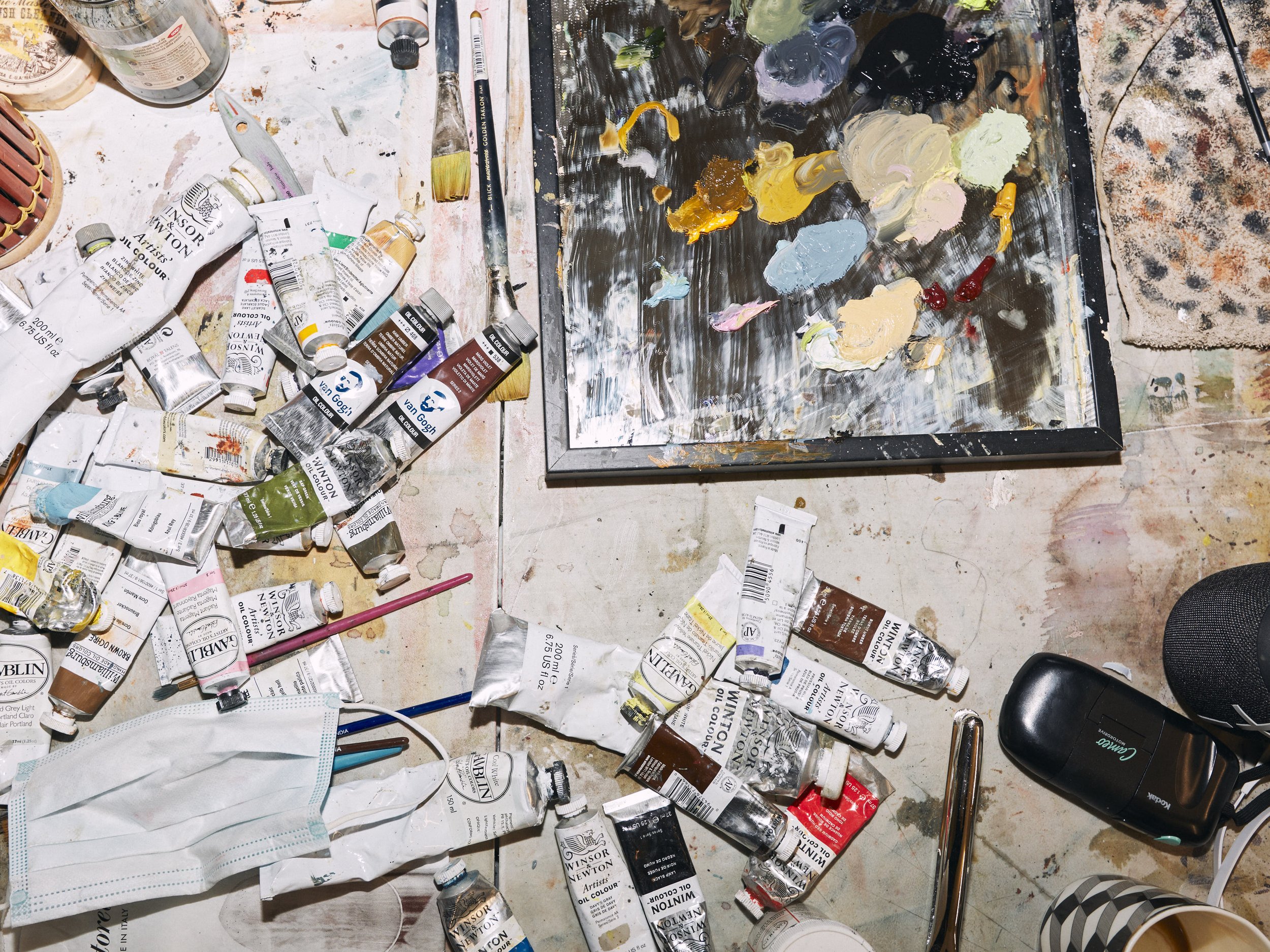Kate Mosher Hall, Moon mesh, 2024
Acrylic on canvas
80 x 72 inches (203.2 x 182.9 cm)
interview by Kathleen MacKay
I recently visited Los Angeles born-and-raised painter Kate Mosher Hall at her light-filled studio in a bricky industrial area of Glendale. With the 5 freeway buzzing nearby, she walked me through her complex and unique process, which involves silkscreening light-sensitive emulsion over gessoed canvas using anywhere from eight to thirty screens depending on the particular painting, Photoshopping, layers of collage, and paint. It’s a “choose-your-own adventure” as she says, to get the desired effect. To help organize things, she’s created a lexicon: box paintings, hole or mesh paintings, recursion paintings. Some paintings incorporate elements of all styles. Hall, a punk drummer, worked in silkscreen studios for several years before she began UCLA’s Fine Art MFA program. We talked about Never Odd or Even, Hall’s second solo exhibition at Hannah Hoffman, which is currently on view in Los Angeles and the way that the work employs both good and bad math, challenges modes of looking, and the infinite repetition within binary relationships.
KATHLEEN MACKAY: Let’s talk about paint. The works in Never Odd or Even often have a charcoal wash, right?
KATE MOSHER HALL: I use charcoal but also flashe, which has that really dry matte look to it. It's really dense, really rich. It's important for me to have matte-ness in the blacks because I work with themes of obfuscation; things that you can't see versus things that you can see. Sometimes I like it when there's like a slip of: is it void or is it obstacle? Matte-ness gives in to that.
KATHLEEN MACKAY: And you're talking about the "hole” paintings you make?
KATE MOSHER HALL: Yeah. The "mesh” paintings. Sometimes I'll print paintings backward. I'll do a black background and then I'll print everything inverted with white or with a color. The "recursion” paintings are made reversed actually, so that black matte sets, because those are a two-point perspective receding into space. That matte-ness becomes really important.
KATHLEEN MACKAY: The "recursion paintings"—those are layers of silkscreen on top of each other, the same repeating image over and over until a center point?
KATE MOSHER HALL: It repeats, but it's also in succession of an image. So there's a bit of that repetition. Then, it evolves as it goes in. This idea is about quantity or quantifying an image. I'll take something and when it's spread out into space, it's like the way one experiences time, or something repeated into the abyss, again and again and again. It's a response to seeing images again and again and again. You know, like the deep-fried meme? Like the thing screengrabbed. I’m taking the thing that is already flattened out but expressing it as quantity.
KATHLEEN MACKAY: The idea of repetition/replication is so great with your work because it’s totally a different experience for me being in the room with those “recursion” paintings versus seeing reproductions of them.
KATE MOSHER HALL: It's a huge part of it.
KATHLEEN MACKAY: Especially my favorite 31,556,952 seconds. In person, there's this moiré thing going on that's really trippy and a little bit dizzying that's totally lost in any reproductions.
KATE MOSHER HALL: I think a lot about the proximity to my work. How it looks up close and far away. Sometimes, when you're really far away, things will start appearing or walking in. And when you're close, they sort of fall apart. What the camera does is compress all of the resolution that I'm playing with in the paintings. So, if things have a smaller or higher resolution next to each other, the camera just makes it all the same resolution. The moiré pattern resists it. It's fun making work that refuses to be photographed—work that's about images and photographs.
Kate Mosher Hall, 31,556,952 seconds, 2024
Acrylic and charcoal on canvas
80 x 72 inches (203.2 x 182.9 cm)
KATHLEEN MACKAY: It's very rebellious in a way, like, yeah, you had to be there. It's kind of punk. And what you're saying about how the camera wants to put its arms around everything all at once—that's not really how the body experiences something, how the eye takes something in.
KATE MOSHER HALL: Yeah, I was thinking about these ways of seeing in multiplicity. I'll be experiencing a conversation with a friend and check my text messages at the same time, and we're also in the car and I see this billboard. All these rectangles presenting information within the world that I'm interacting with feels like these multiple horizons, which is a wild thing to actually navigate.
KATHLEEN MACKAY: Layers of screens.
KATE MOSHER HALL: Or even just things out in the world. People. Something on a t-shirt, who knows? There are so many ways things are presented, contained in, shown. One thing I want to say about the title, the [Seconds] recursion painting: that's the number of seconds within a year. And the source image is a one-year-old's birthday cake.
Kate Mosher Hall, Pull up pull up, 2024
Acrylic and charcoal on canvas
Diptych dimensions: 90 x 160 inches (228.6 x 406.4 cm)
KATHLEEN MACKAY: It seems like you're doing a lot of math in your work.
KATE MOSHER HALL: I guess I'm interested in math. In the process for sure, when you're working with grids, and dot patterns, and ratios, and stuff like that. There's good math with the screening and then there's bad math, and I engage in both.
But math does come in a lot in my work. My friend and artist Olivia Mole came to the show, and we were looking at the large diptych, Pull up pull up. It's the most abstract work I’ve ever made. I left it more open conceptually than I usually do. My big focus is modes of looking and the act of looking, how something’s presented, public or private viewing spaces. But with this work, I'm actually kind of letting it go.
Olivia was like, “How do you feel about math?” She said hyperbole curves are these graphs that go positive/negative, so like 1x1=1, -1x-1=-1, and there's a mirrored curve that happens. Each axis is infinity; it goes on forever. At some point, somewhere in time they make contact. It's like imagining the painting going into the wall, going around into the building, and looping back around and coming through. And then I was like, “Olivia, this is crazy because the title of the show is a palindrome: Never Odd or Even is the same forward and backwards. So is Pull up pull up.” She basically mathematically figured out the thing I had a language relationship to.
KATHLEEN MACKAY: I was definitely thinking about the concept of the infinite looking at your work. It first came to me in the Seconds painting because there's all these layers going inward, inward, inward. And in the middle, there's a spiral or a Greek key that feels very much like it speaks to the idea of the infinite. Like how humans are obsessed with infinity because our existence is so finite. We know it's out there, we know it's all around us. But everything we have is so physical, so tangible, so finite.
KATE MOSHER HALL: I also think it's being in the threshold where we are with technology and our bodies navigating this changing landscape of how we access information, the quantity of information that we see. Like, we have to have a talk about Instagram because it's insane.
KATHLEEN MACKAY: Especially if you're doing box paintings. It's just a million boxes.
KATE MOSHER HALL: Boxes, yeah. But also like the juxtaposition of those boxes in the content. That scroll is really disorienting. It's confusing. It's also schizophrenic, like, oh, they’re selling me eye cream, and here’s my friend's birthday, an art show, and genocide. Seeing all these things stacked up, the timing of it, how do you respond to that sequence that quickly, and engage?
KATHLEEN MACKAY: And we're told that it's all real and it's all fake.
KATE MOSHER HALL: And it is.
Images Courtesy of the artist and Hannah HoffmanGallery, Los Angeles. Photography by Paul Salveson.
KATHLEEN MACKAY: And it's infinite, the scroll. That reminds me, I was thinking about your work and reading Emmanuel Levinas who was talking about humans reaching for infinity—the infinite in the finite—has to do with a desire that can never be satisfied. It's a desire that only arouses.
KATE MOSHER HALL: I think that was built off of Lacan’s Peek-a-boo. I took this amazing class with Lesley Dick on the death drive. Peek-a-boo with the mother is sex and death. It becomes a part of the pleasure principle. She's covering up her eyes: Mother's gone, she's dead. Her return is a dopamine hit. It's pleasure but then it's related to that feeling of emptiness. And it's like Warhol's car crash paintings; the repeating image, the rubberneckers. Death is also related to the infinite. And then, the finite is related to pleasure.
KATHLEEN MACKAY: Do you think pleasure is related to the infinite?
KATE MOSHER HALL: That's the curious part.
KATHLEEN MACKAY: And death is, of course, related to the finite because—kaput—it's your day.
KATE MOSHER HALL: I think in any of these binary relationships, it always just goes into repetition, like their relationship with each other becomes infinite because it's inconclusive.
KATHLEEN MACKAY: And that's lovely with your work, the binary that has to do with photo processing and light and dark, and inversions. I'm curious about the show at Hannah Hoffman, these big, dark paintings that are very affecting to be in a room with, they draw you in, the eye travels over them, one wants to spend a lot of time with them, and there's a kind of moodiness; a darkness and a somber feeling. But some of your earlier work is very playful and lighter. I'm thinking about that painting of the dog running on the beach with the mirror behind it, and the dog is in this really funny dog-shape.
KATE MOSHER HALL: I was feeling really conflicted making the show because I was feeling like, why the fuck am I even making art while genocide is happening?
KATHLEEN MACKAY: This is happening around October 7th?
KATE MOSHER HALL: Yeah, I thought about canceling. I was feeling really conflicted and really questioning where my energy should go. A lot of artists shared the same sentiment. I think I was confronted by that feeling and being present for it. It’s also connected to the internet, right? Images, access to information. A lot of emotion, but we’re in this chaos market. In astrology, my Virgo sun is in the 12th house, which is the house of death and aliens and drugs.
KATHLEEN MACKAY: And insanity, prisons, institutions…
KATE MOSHER HALL: So fitting. Even sometimes if I'm having an analytical approach to making an image, I'll be like, this is how the thing is going to be made, this is how it's functioning. Sometimes it's really strange to me and surprises me with how the creepiness comes in. The moodiness, the darkness is such a shadow side of how I'm making things, sometimes I'm like, what's wrong with me?
Kate Mosher Hall, Squeeze wax, 2024
Acrylic, flashe, charcoal, and color pencil on canvas
92 x 84 inches (233.7 x 213.4 cm)
KATHLEEN MACKAY: Your process seems so physical. Is that part of it?
KATE MOSHER HALL: I guess so. I've been doing this for so long that I don’t think a lot about all the labor. When I'm not actually making the painting but making the parts that are going into the painting, it’s a nice moment for reflection.
KATHLEEN MACKAY: You’re a drummer too—also physical.
KATE MOSHER HALL: I'm actually not really good at drumming, to be honest.
KATHLEEN MACKAY: Do you have natural rhythm, though?
KATE MOSHER HALL: I have theories about this. I think I was actually born left-handed because when I snowboard or skateboard or anything like that, I ride goofy. When I first started drumming, I was playing backwards a bit. I really like doing dance beats and the separation between my legs and my arms was really hard to break. Because I think that I'm strangely left.
KATHLEEN MACKAY: That's nice with your paintings to think about inversions. You were a punk drummer in the DIY scene, and now you're in the art world. What are the similarities between those, or the differences?
KATE MOSHER HALL: Well, they're really different, but there's also similarities. The art world also has so many genres. There are different modes of making in different communities, and different intentions and goals that come out of art making. When I'm in the art world, I'm rubbing up against worlds I never imagined I'd be close to, like working with multiple commercial galleries. When I went to grad school, it was cool, I can teach now because silkscreen and printmaking is kind of a dying art. There's ironically a lot of interest in it as it's disappearing from campuses, this idea of translating digital image into material. I love the collaborative aspect of printmaking. It really keeps me in the community too, in a way. I'm always like, open door, come print something. Because of that, I feel the art world has opened. And it feels like more of a community. I got here through the support of friends, community, artists, these galleries. So, I try to support others as much as I can.
KATHLEEN MACKAY: What’s next on this front?
KATE MOSHER HALL: I’m actually really interested right now in taking a break from making paintings and I'm thinking about writing a play. I've been thinking about performance quite a bit and looking to use my studio as sort of a showing space—performance space, video, plays, poetry, literature, whatever. There's this new urgency and thirst in LA for collective engagement and feeling the sense of the present moment being performed and witnessed all together.
Never Odd or Even is on view through March 23 @ Hannah Hoffman 2504 W 7th St, Suite C, Los Angeles
Images Courtesy of the artist and Hannah HoffmanGallery, Los Angeles. Photography by Paul Salveson.



